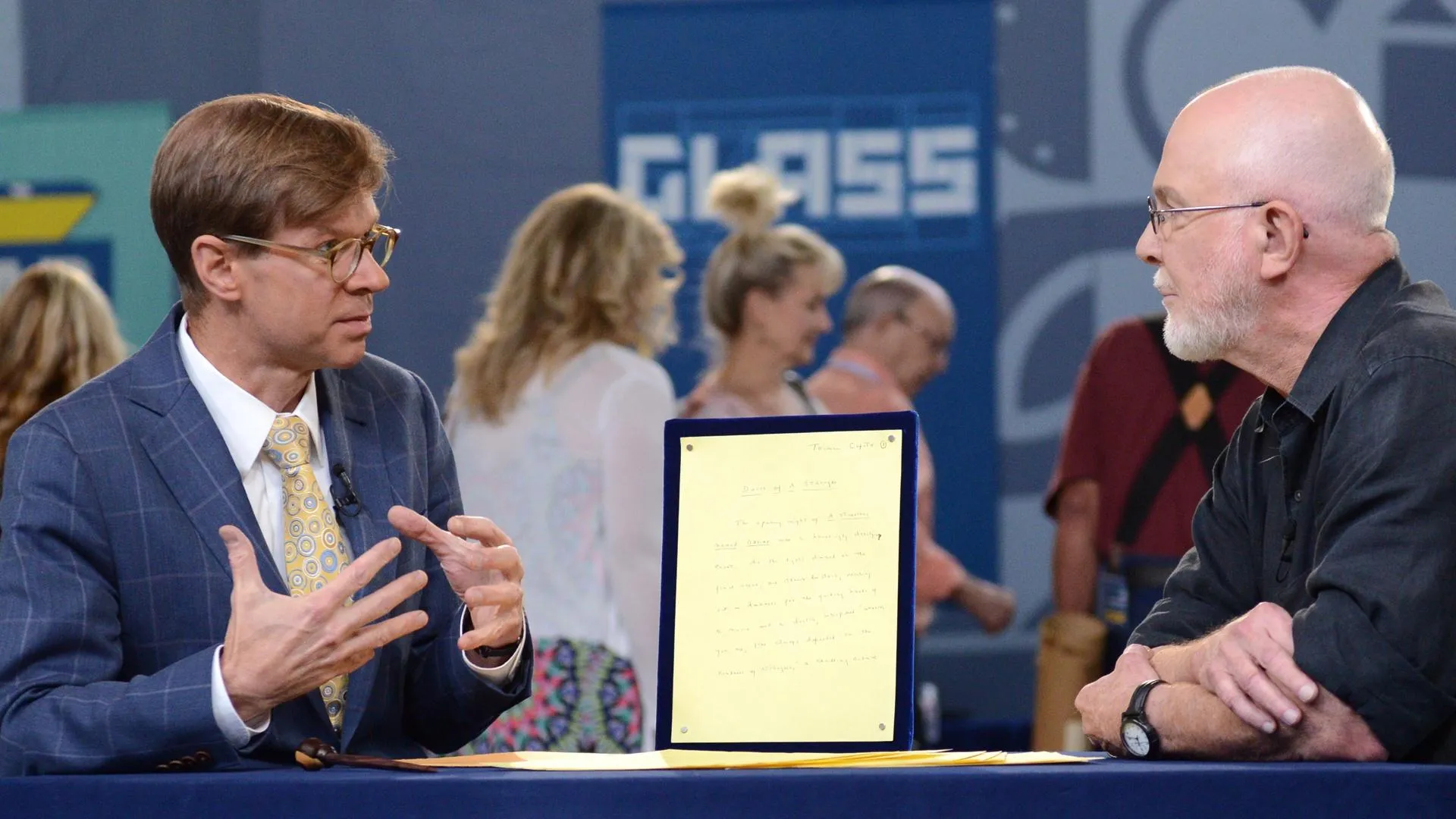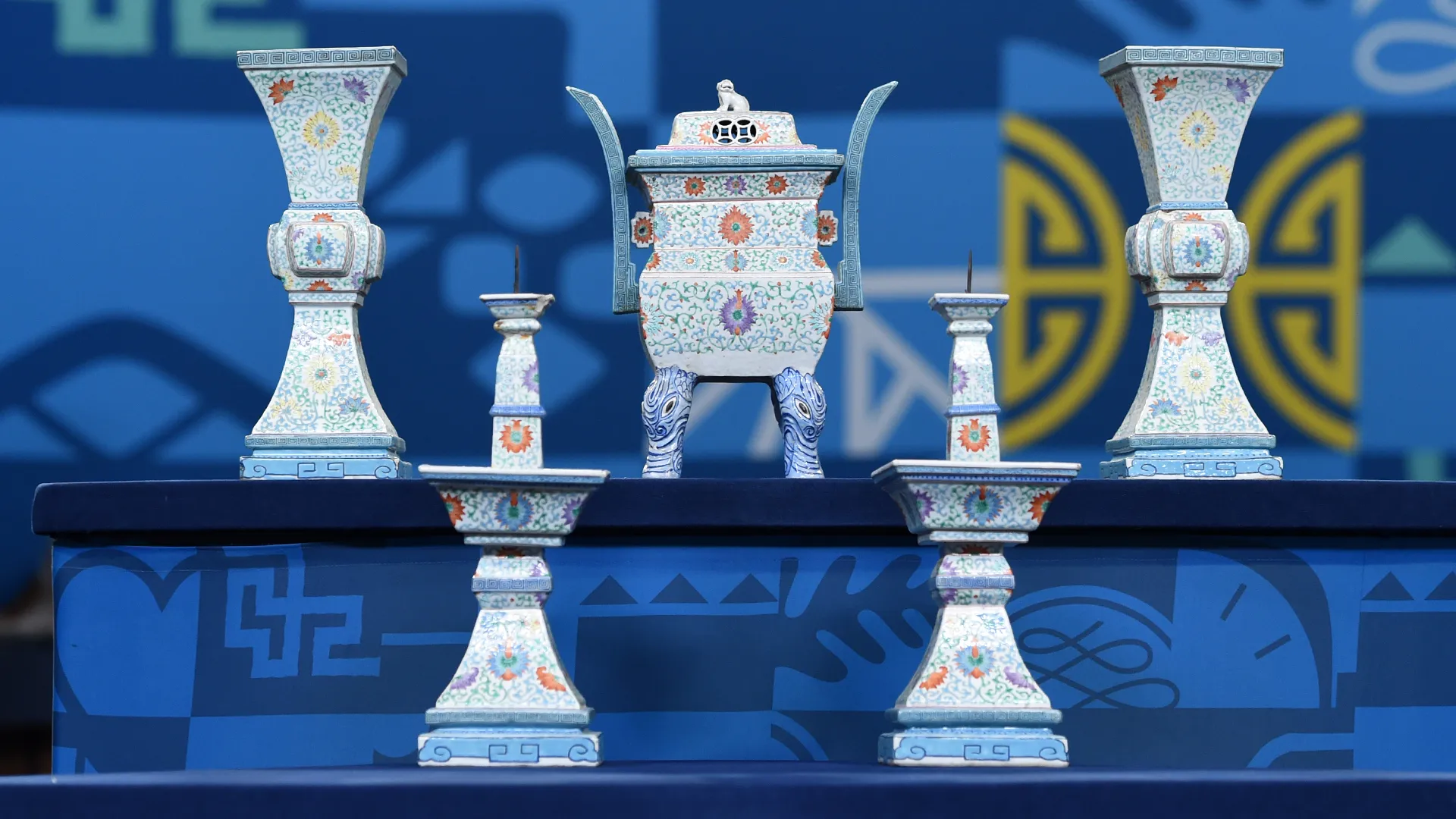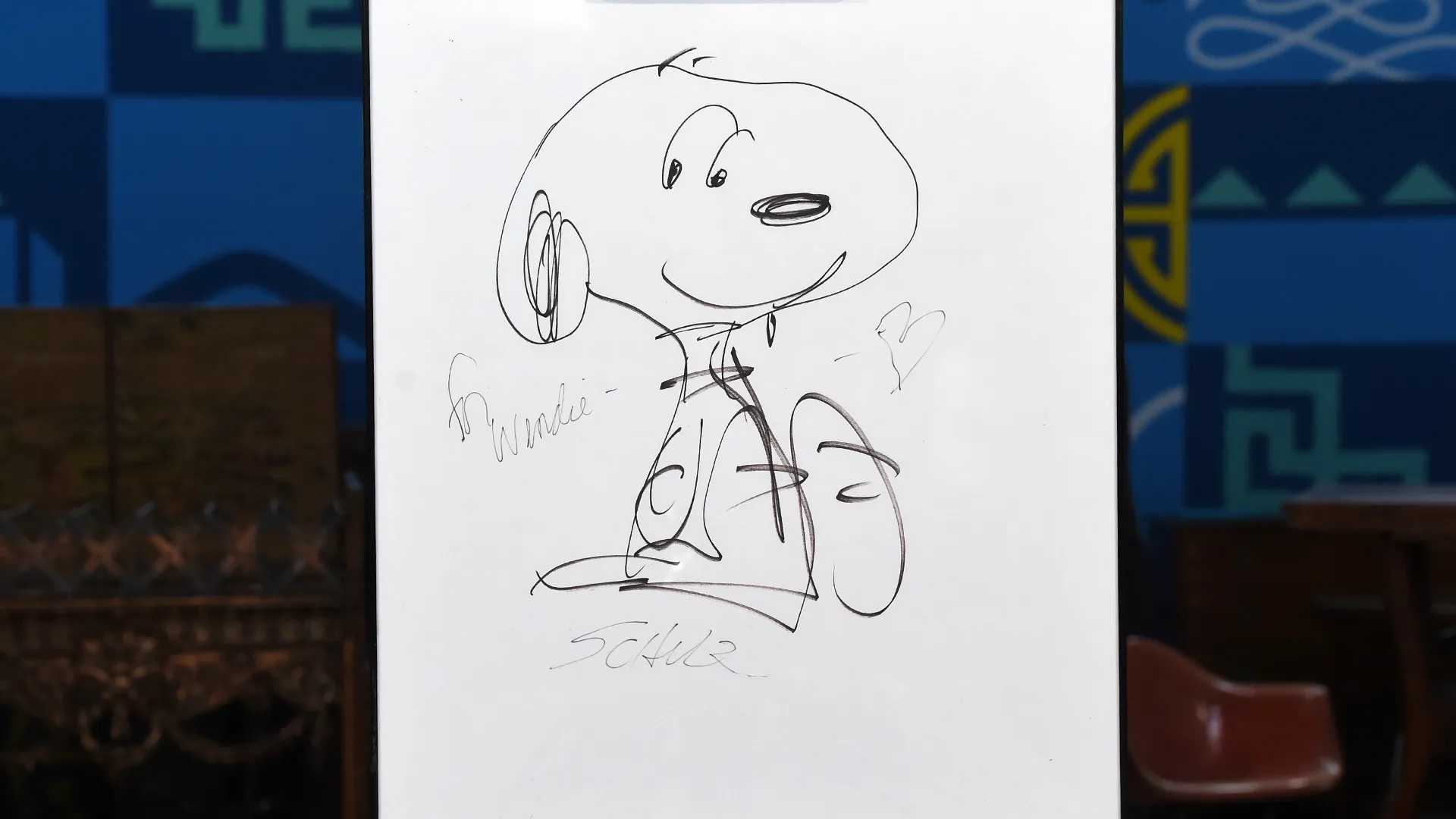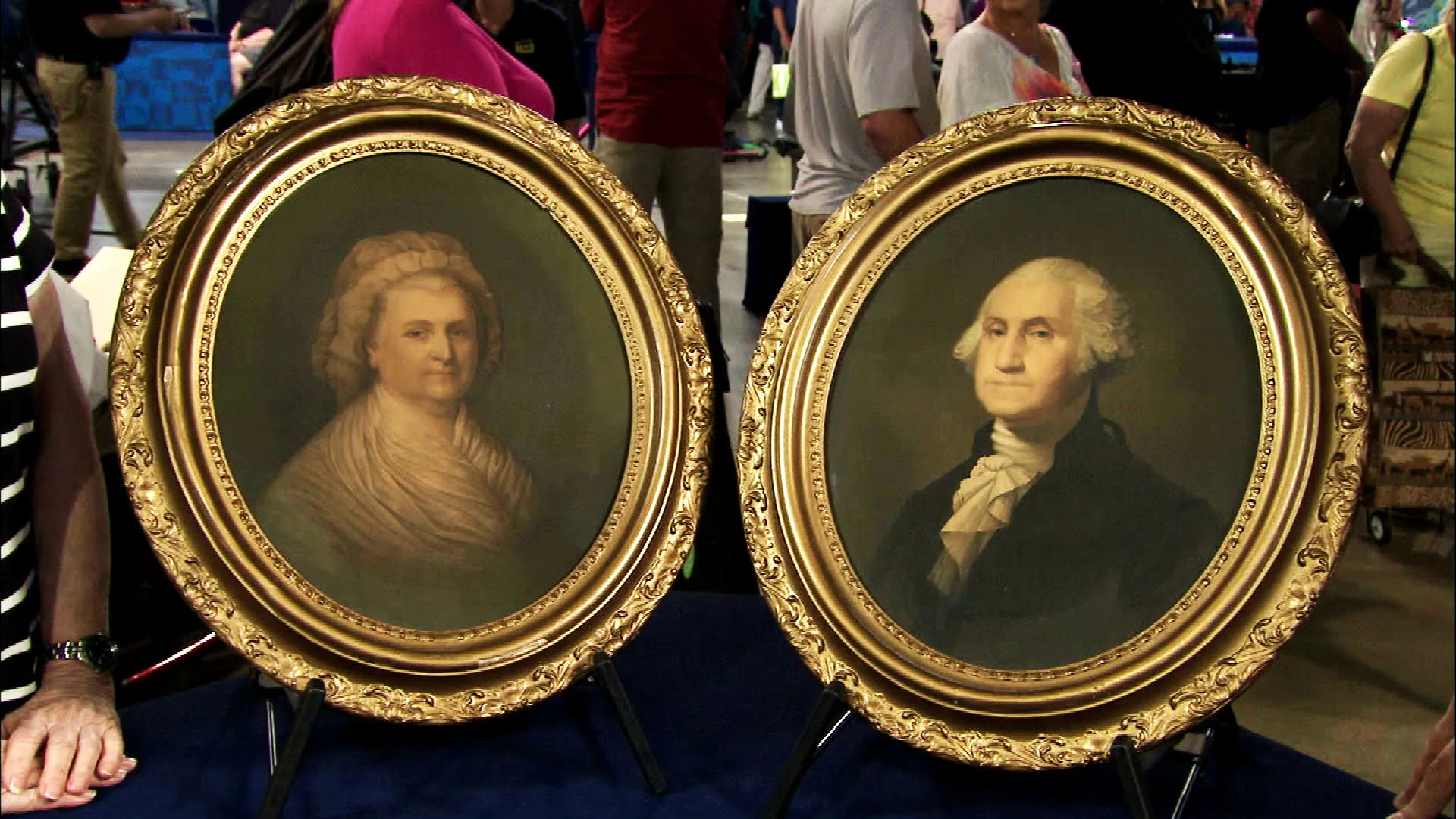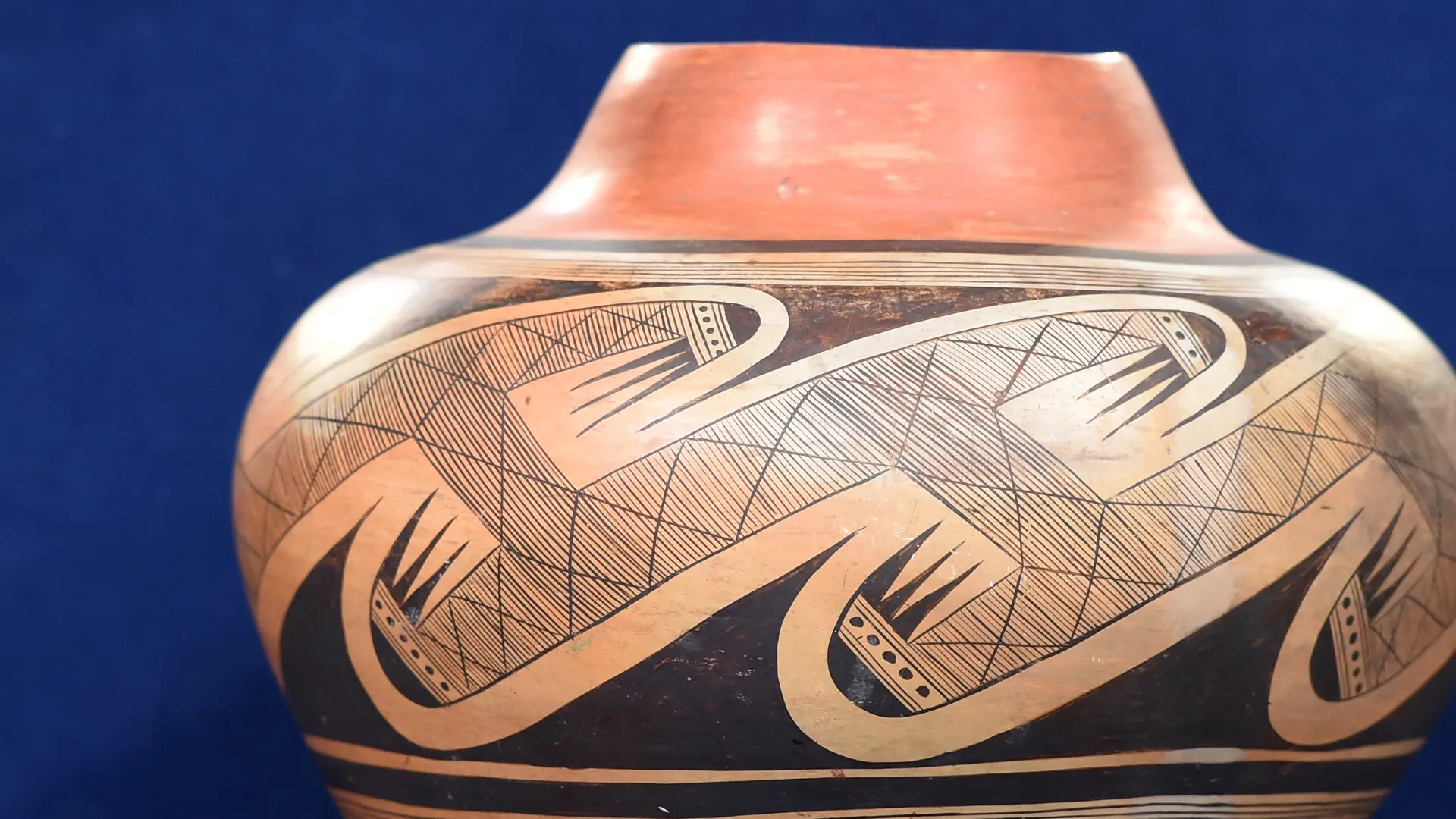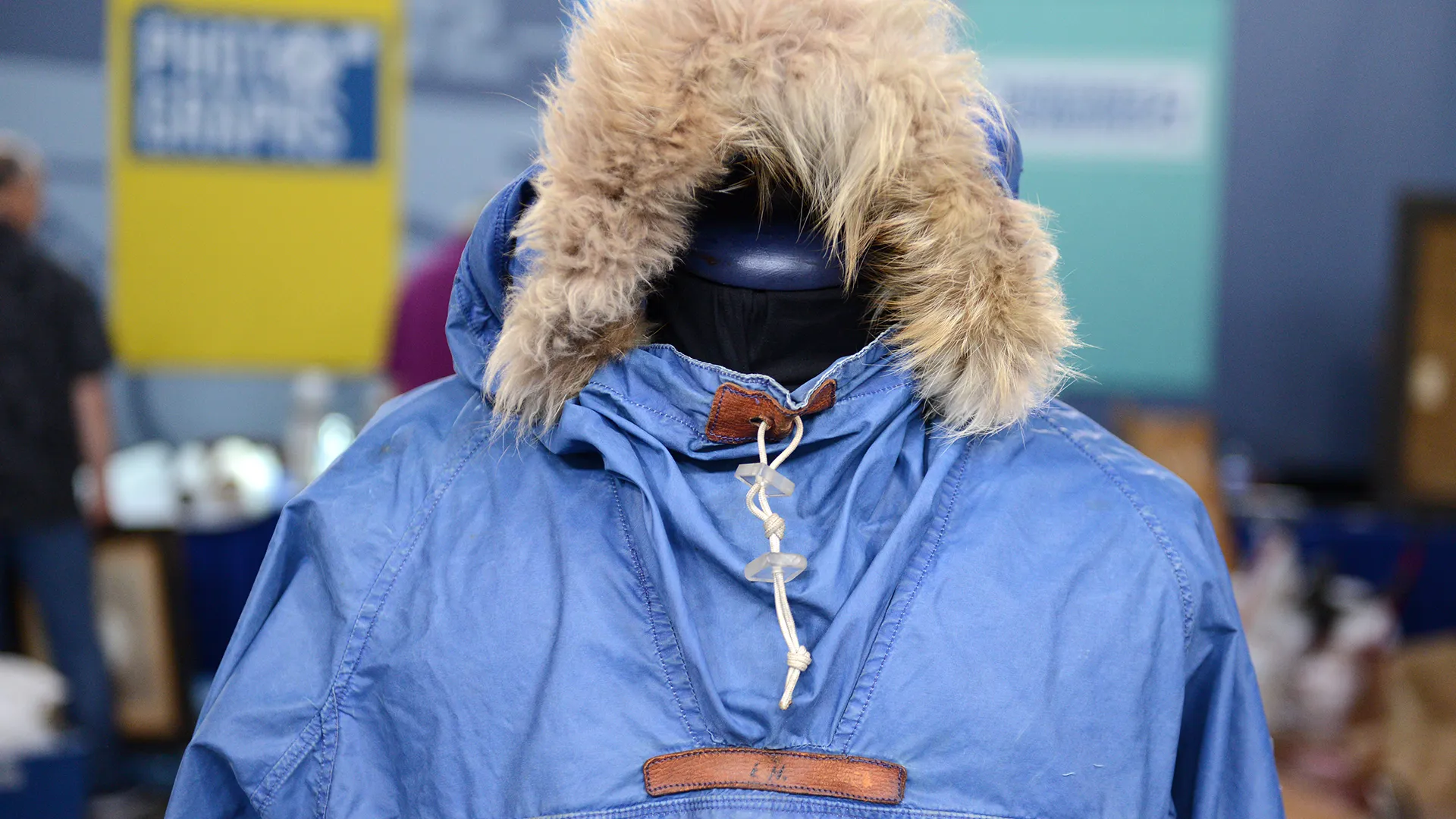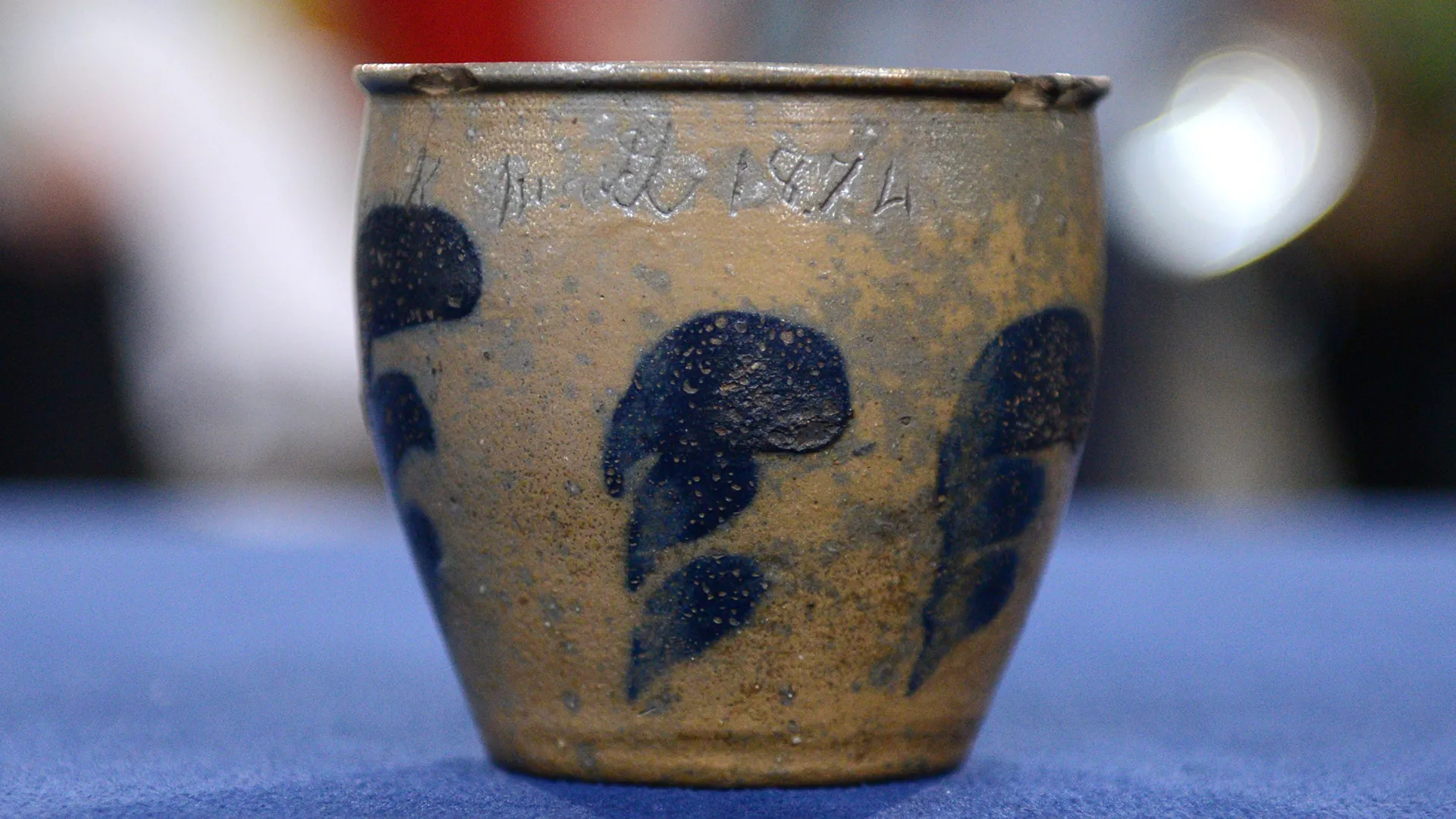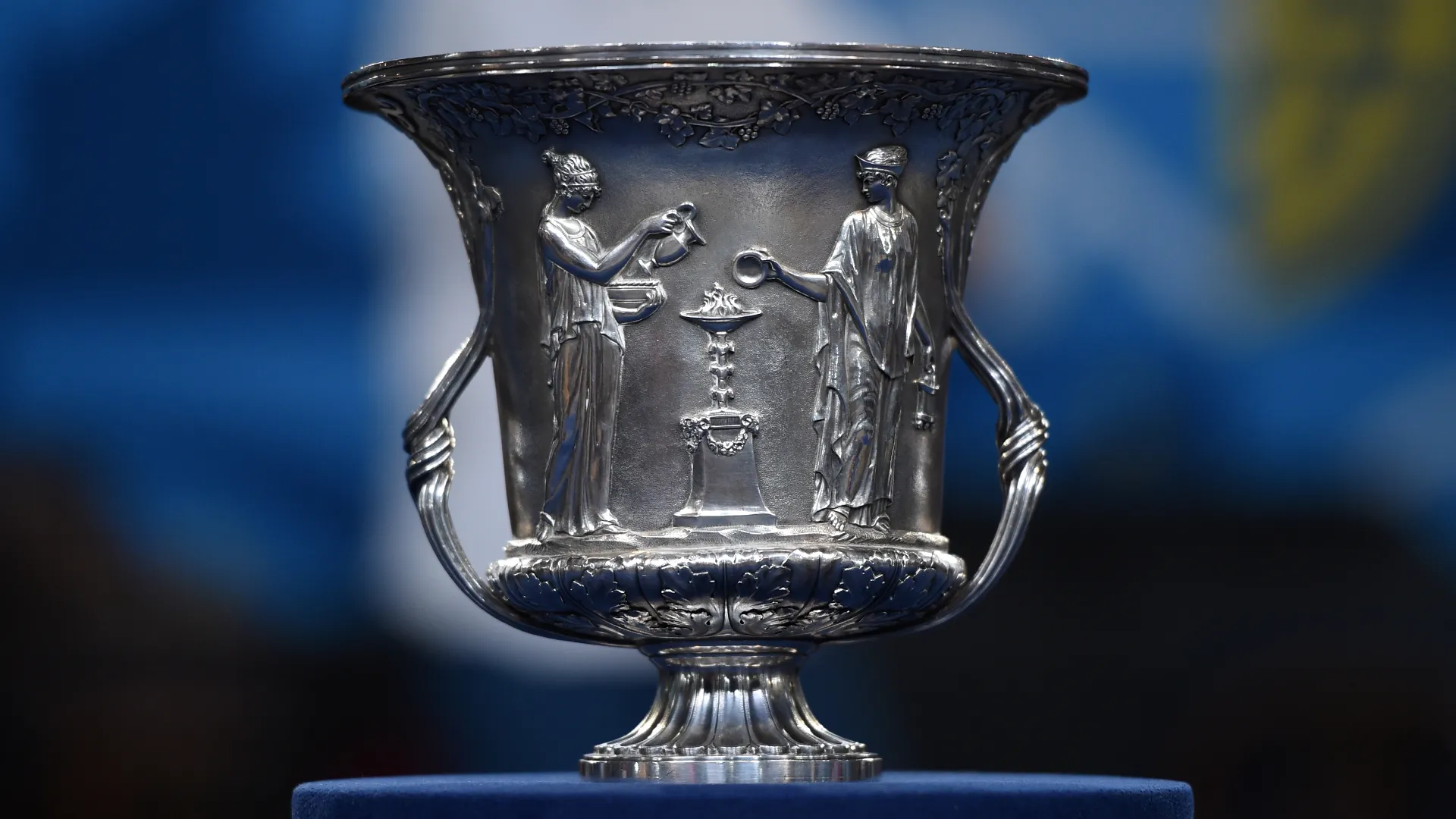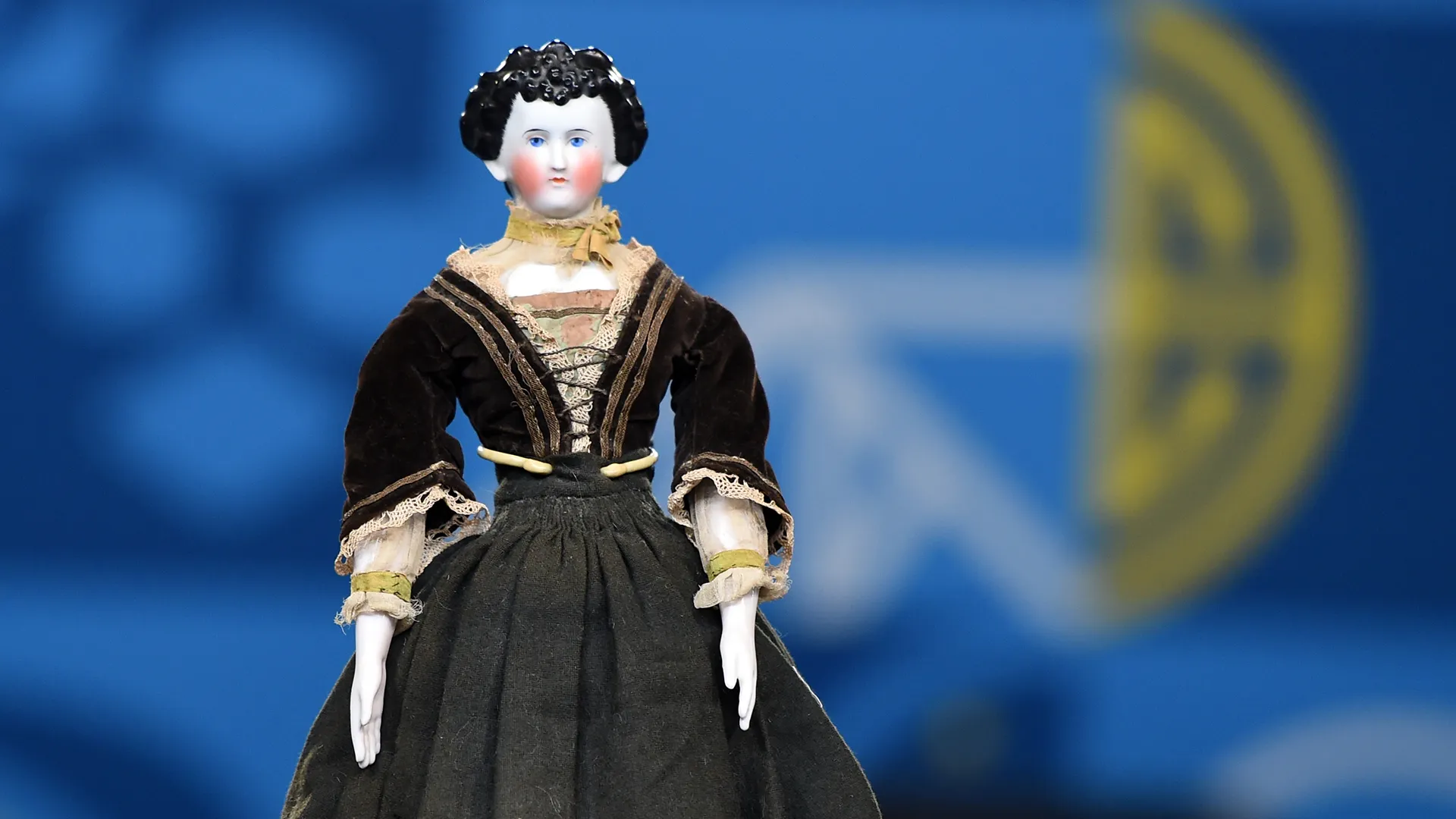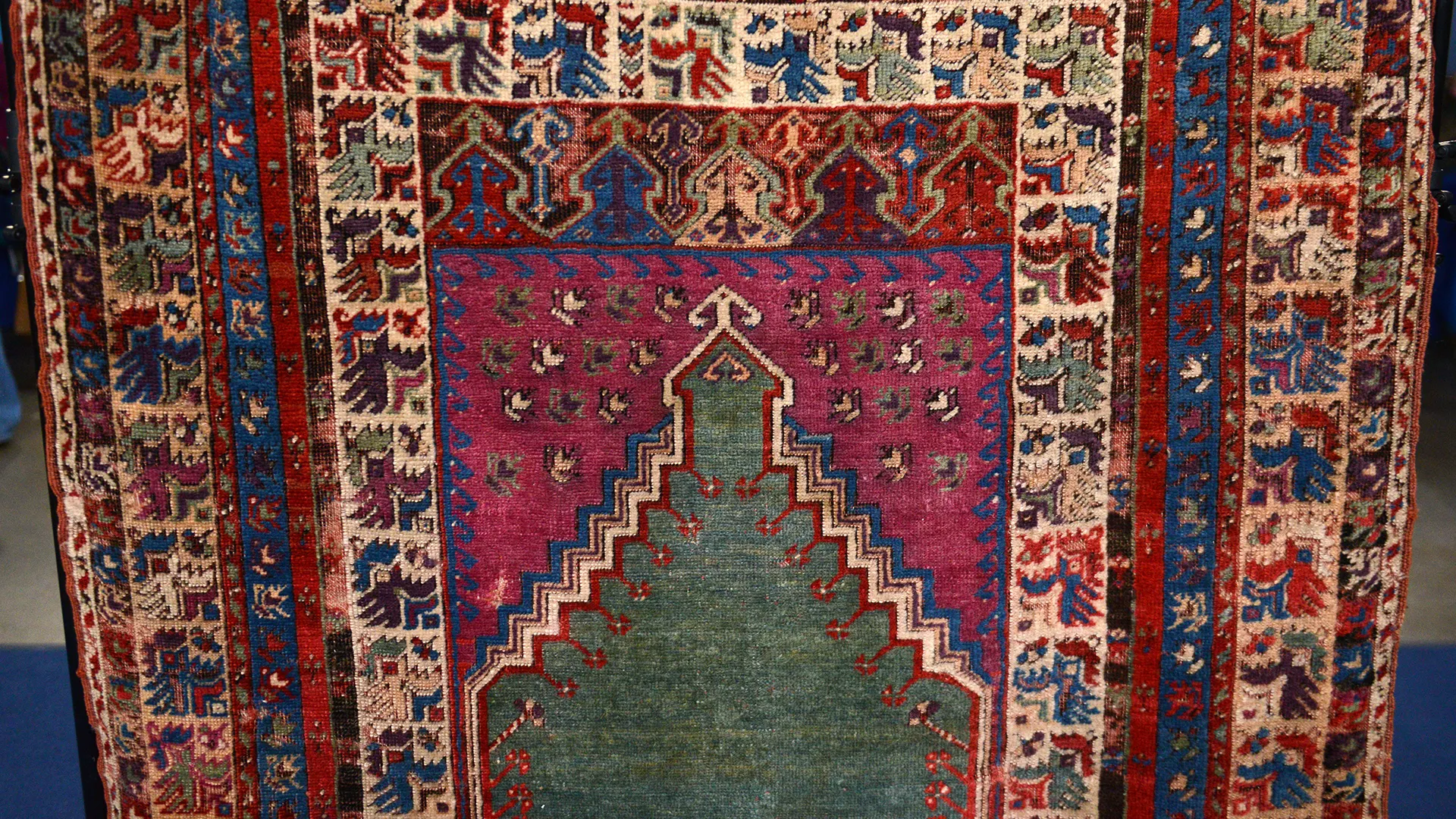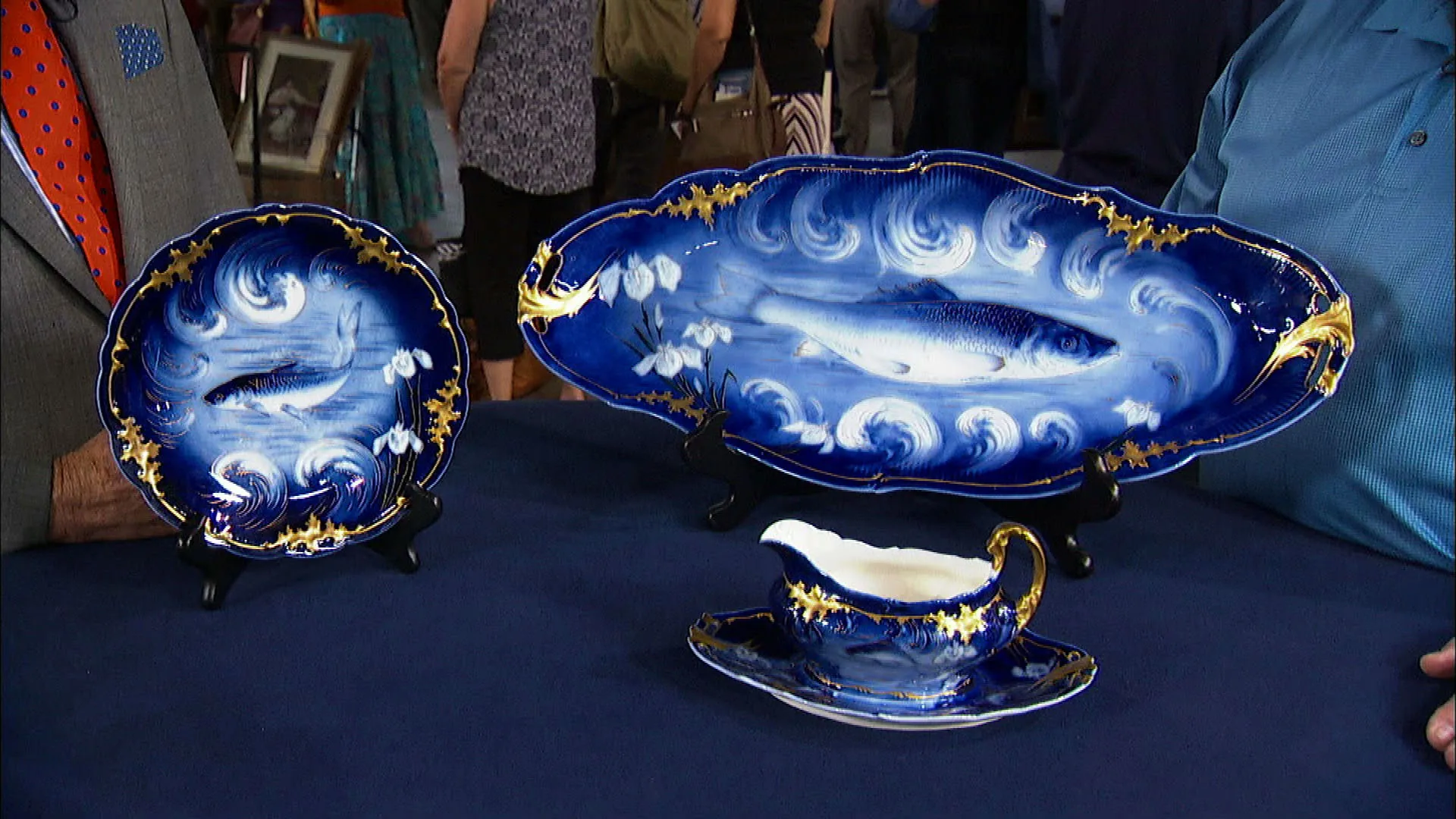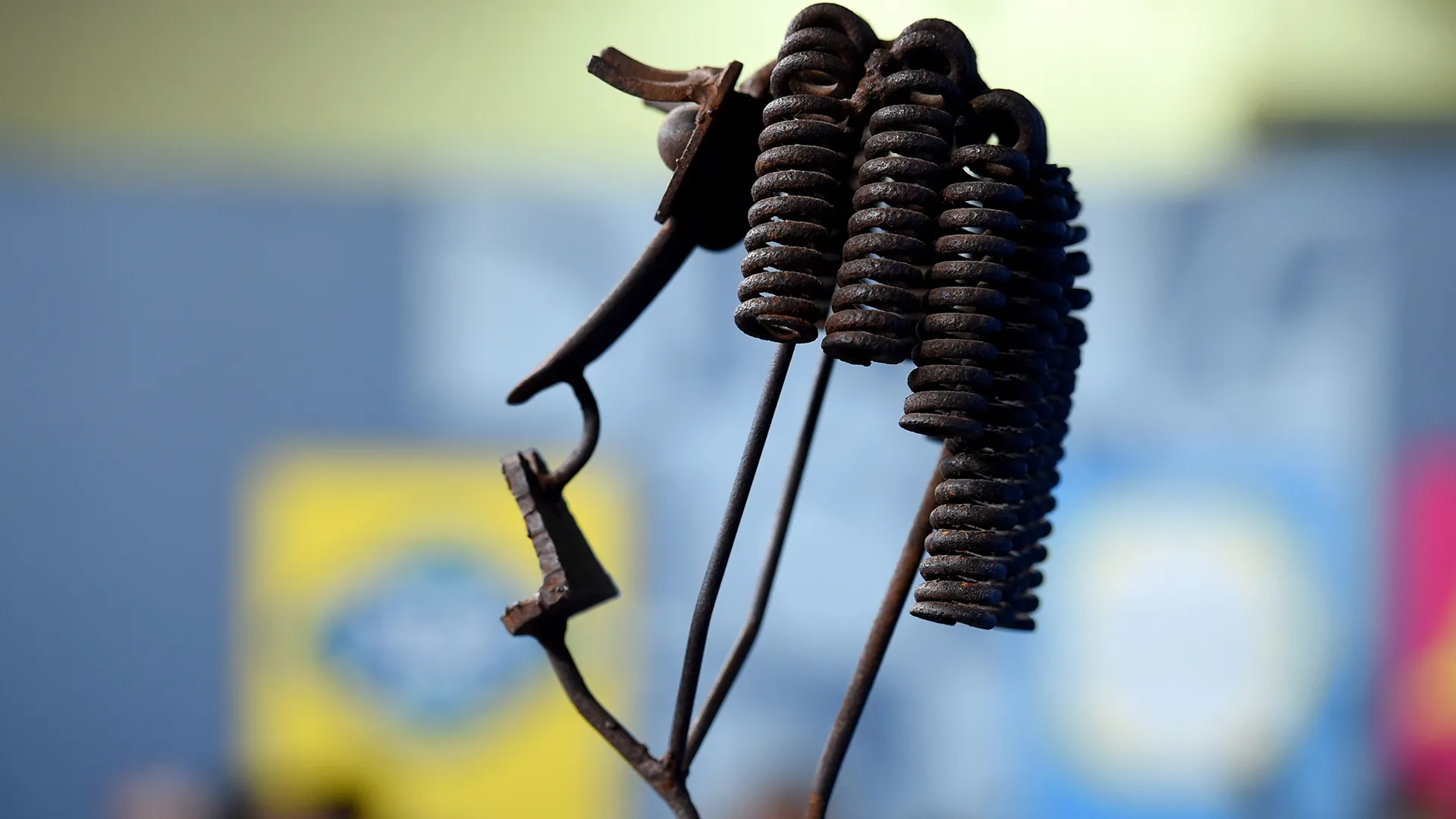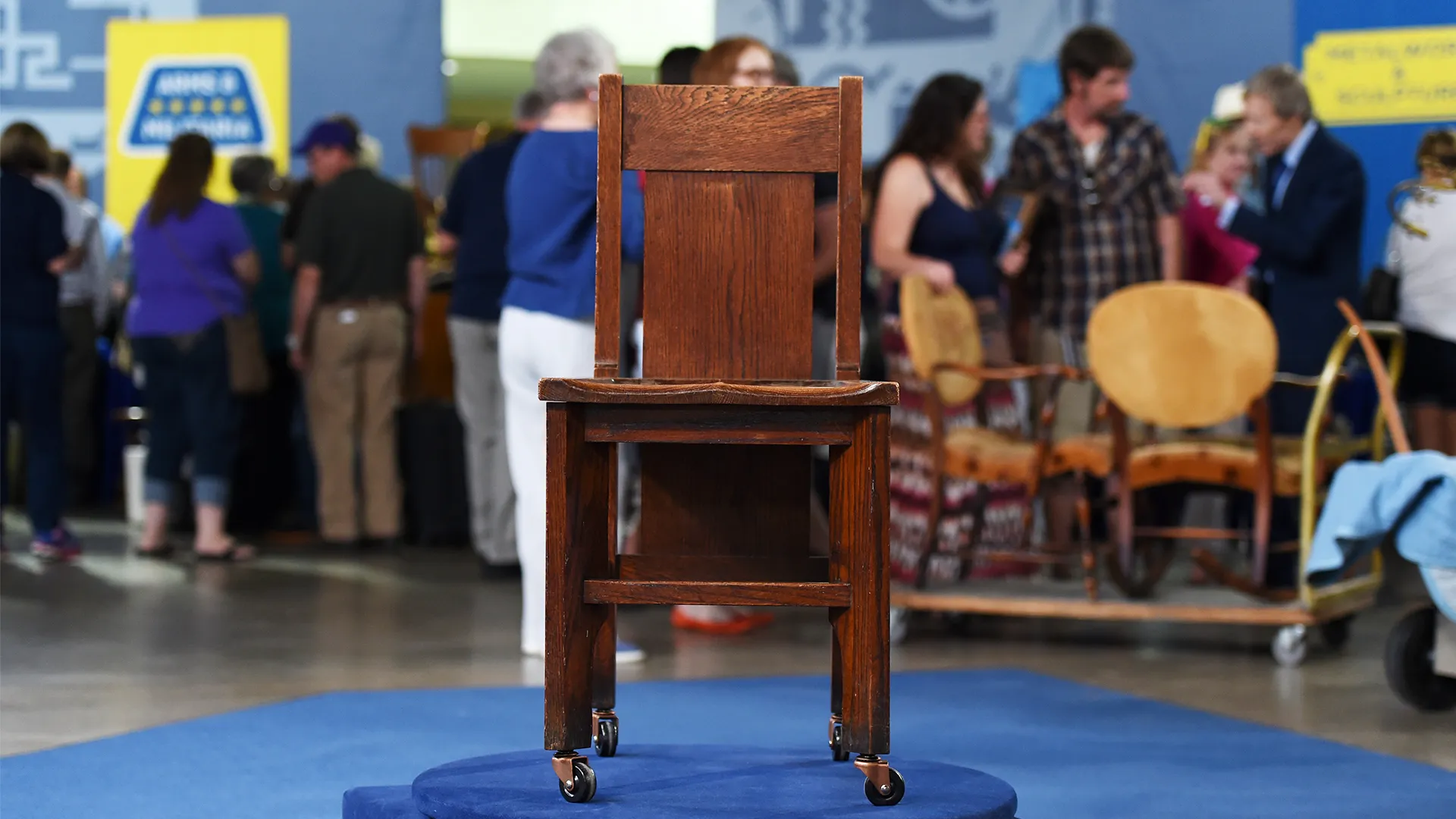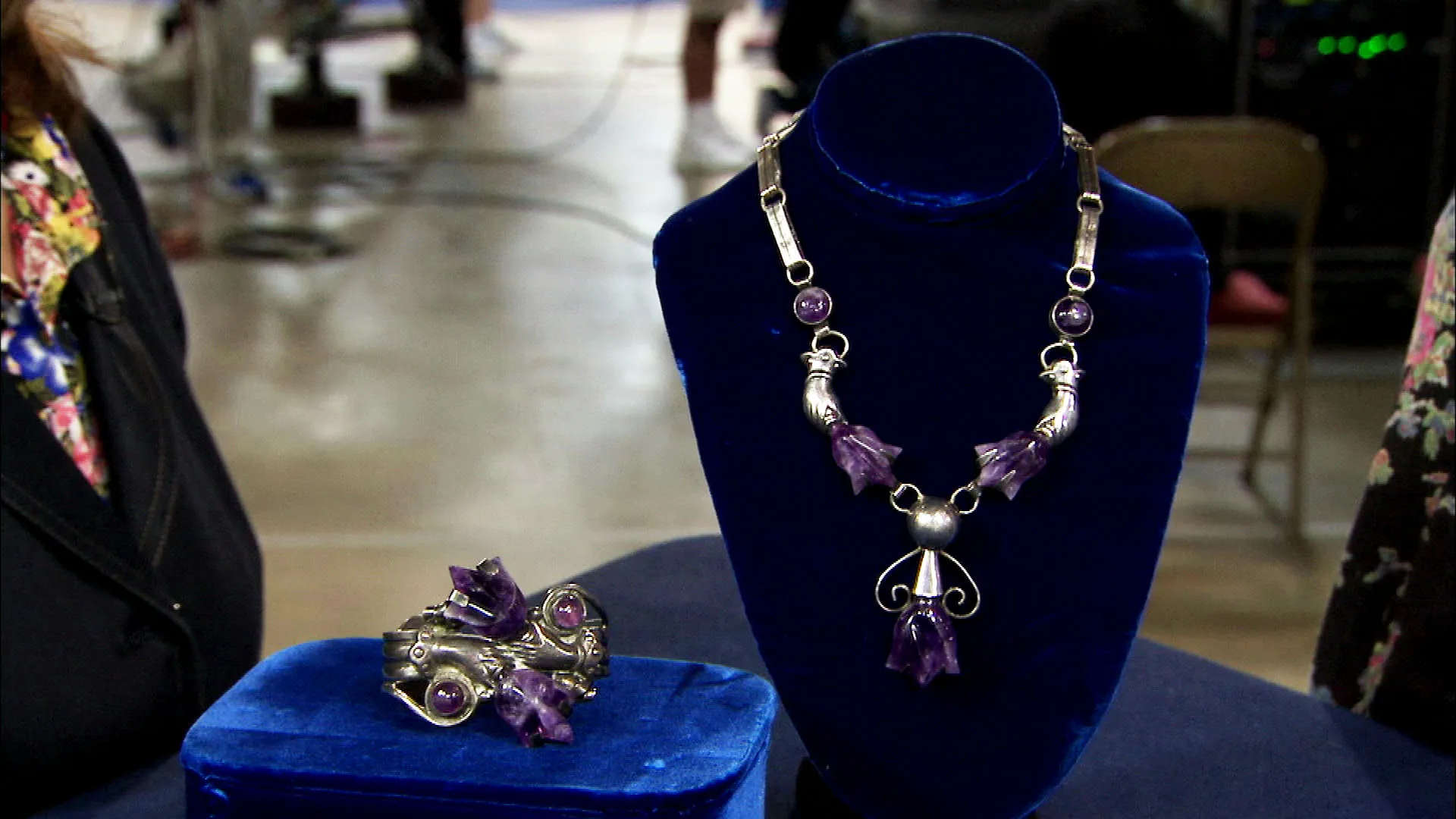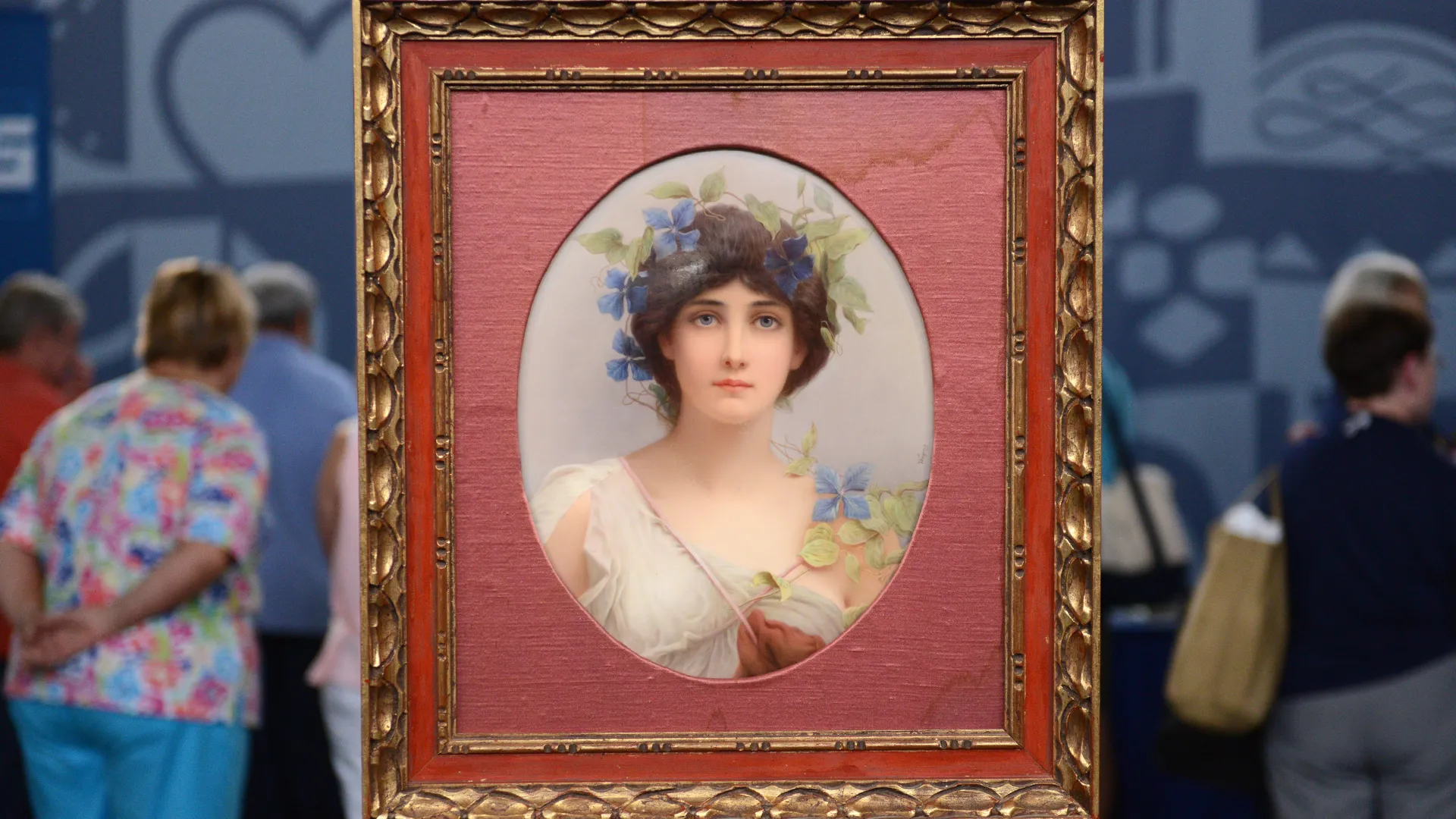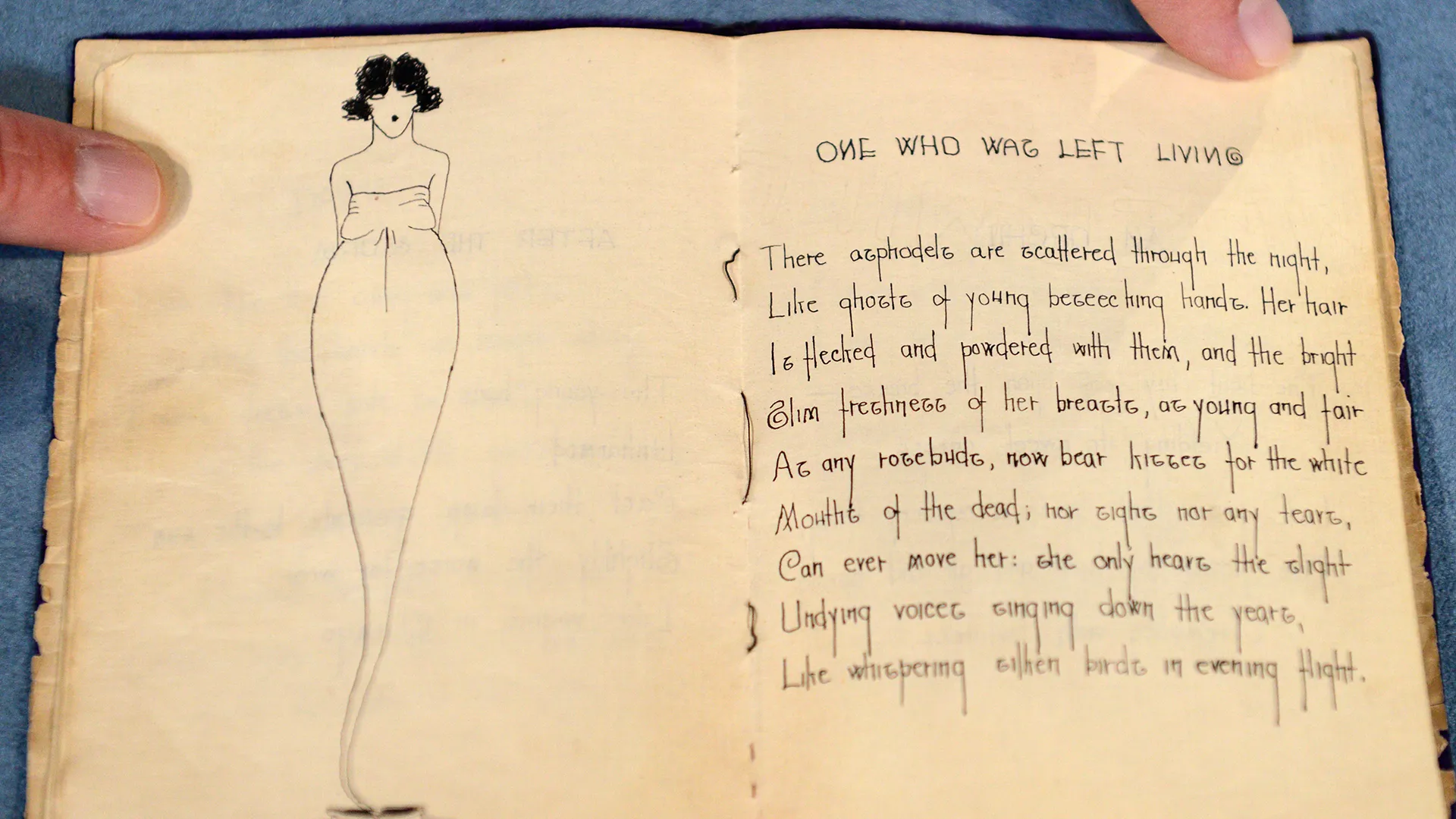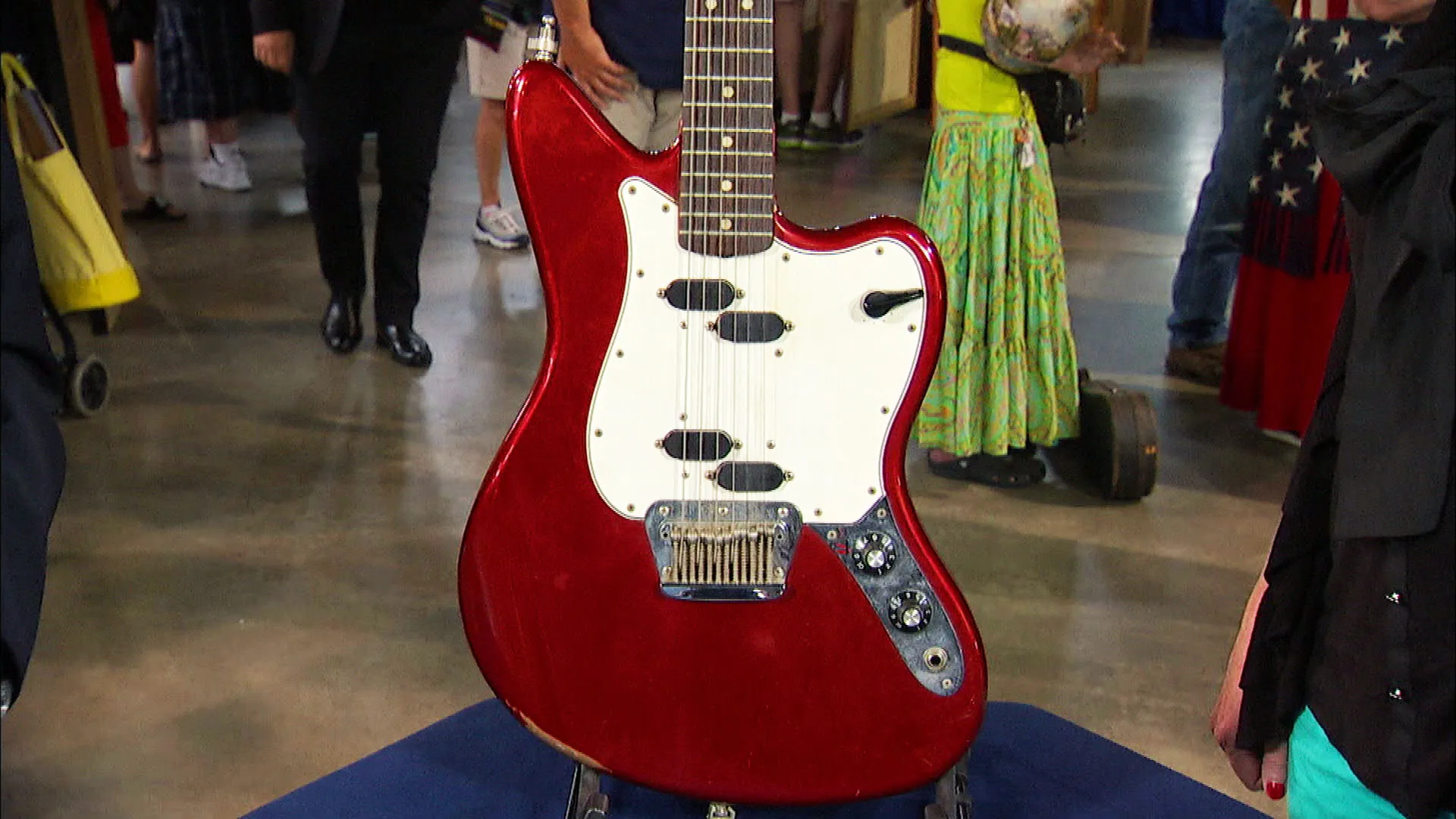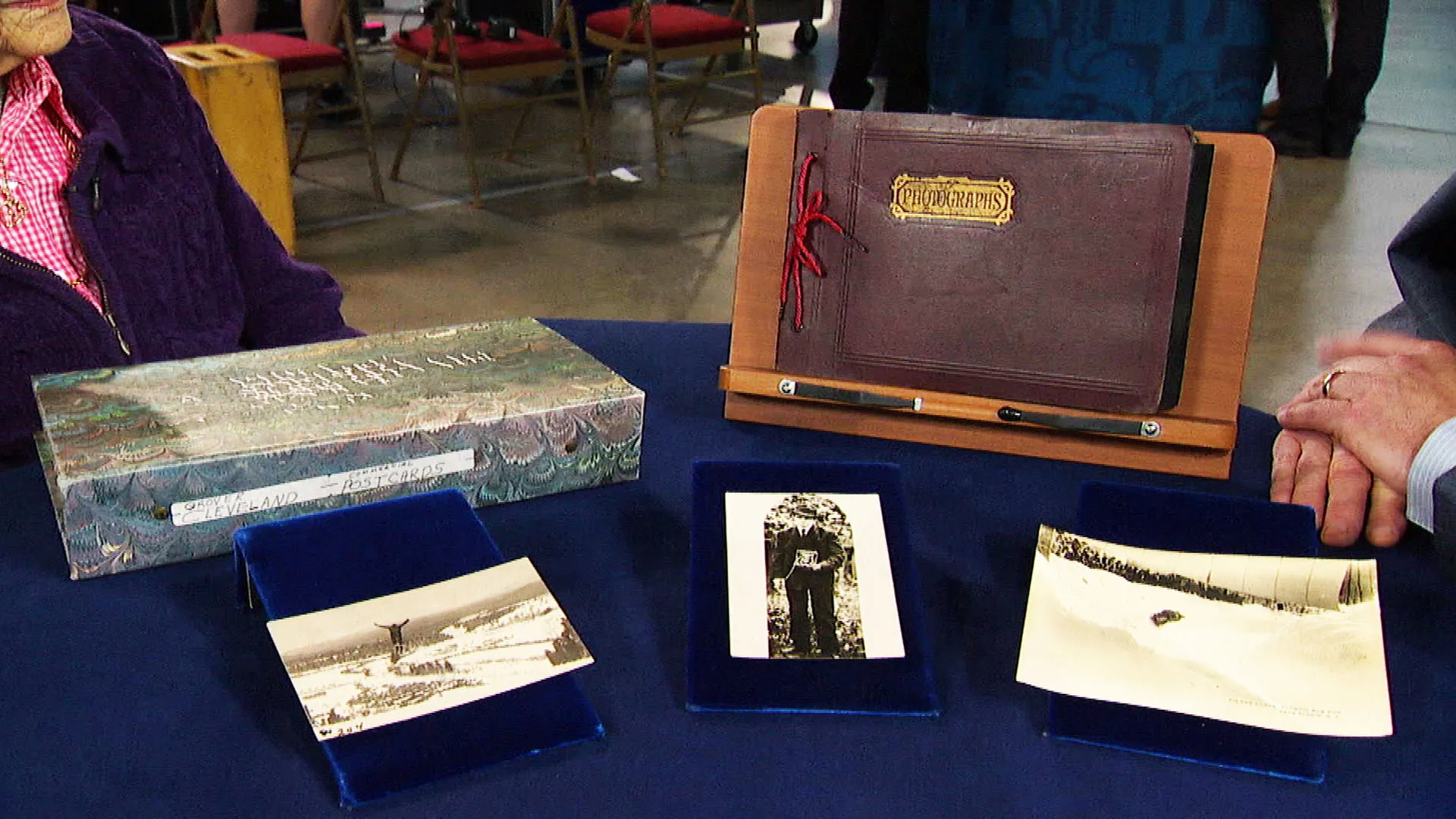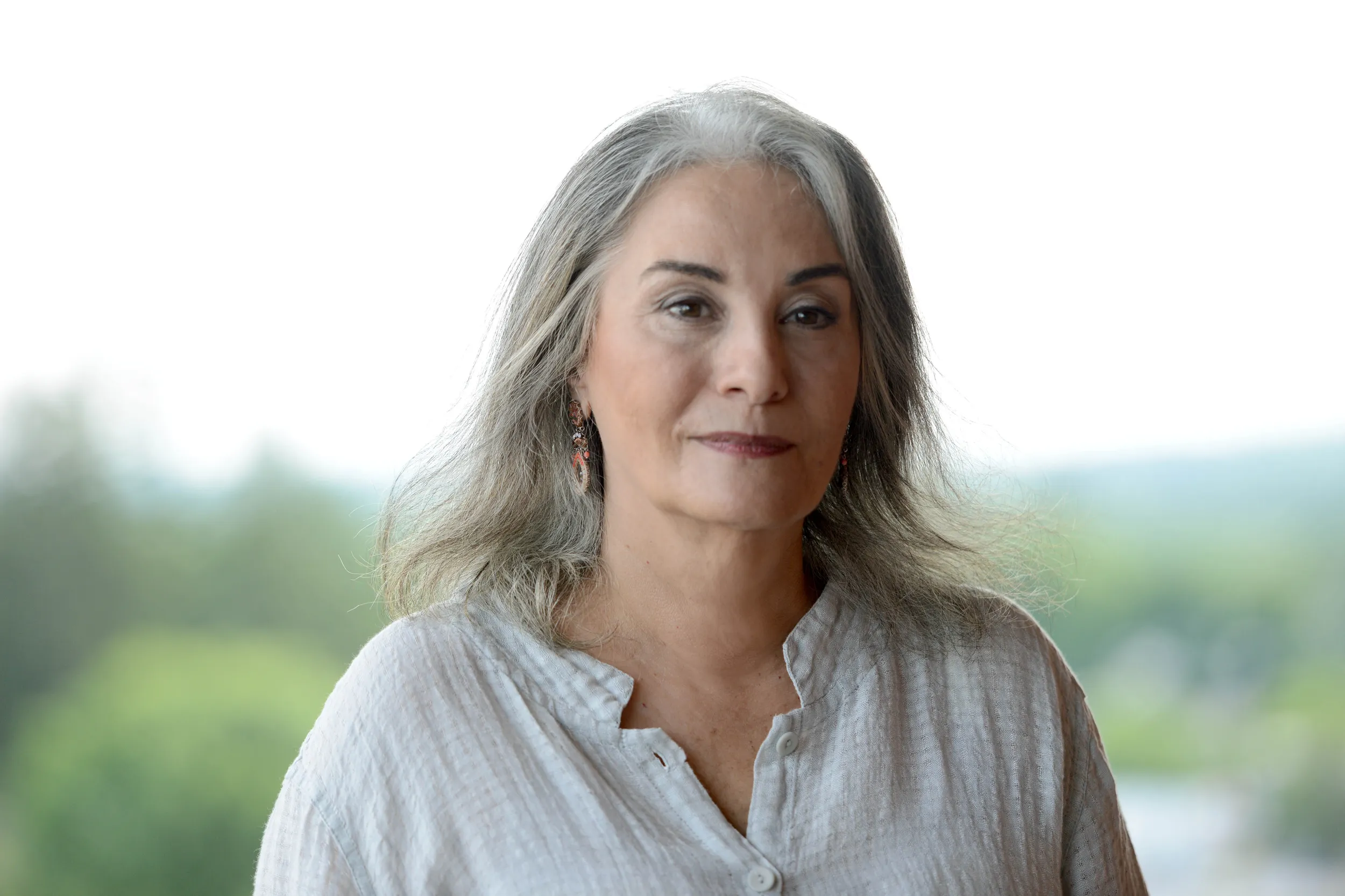HOST: Little Rock is showing off its treasures right now on Antiques Roadshow.
GUEST: She told us that she had a summer fling with William Faulkner.
GUEST: Whoa. Wow.
HOST: You can't visit Little Rock without coming across one of the most famous names in American politics-- Clinton. The Clinton Presidential Center draws hundreds of thousands of visitors every year. Across town at the Old State House Museum, Roadshow saw the elegant inaugural gowns of former Arkansas first ladies, including the dress worn by Hillary Rodham Clinton in 1979. We'll see a jacket worn by a different notable Hillary later on in the show. But now, let's see what Little Rock has to show us.
GUEST: My parents lived in Tokyo prior to World War II. And in about '31 or '32, they used to go to Yokohama for summer vacation, because it was so hot in Tokyo. They came back by train, and the train would stop at several places. And at one of them, there was a monk selling this set. So they took all the money they had left from their vacation, and I mean they pooled it in order to buy these. And I can't tell you how much.
APPRAISER: I think when we were talking, you thought they were Japanese 17th century or something, was what...
GUEST: Yeah. I think they're Japanese.
APPRAISER: This is called a garniture.
GUEST: Okay.
APPRAISER: And more properly it's an altar garniture, common both in China and Japan. This is called a gu. In Chinese terms, this is called a gu, and it's based on ancient Chinese bronze forms. And you get this shape in China and Japan, as you do this center shape, which is a censer, an incense burner.
GUEST: Right.
APPRAISER: So that's also a shape you get similar examples in China and Japan. And the same thing with these candle holders, these cricket candle holders. But what makes this more Chinese than Japanese...
GUEST: Really?
APPRAISER: ...is the decoration.
GUEST: Oh, my gosh. (softly)
APPRAISER: And it's the combination of the decoration with the shape that really tells us that these are Chinese. The decoration is this kind of continuous pattern of lotus blossoms amid scrollwork.
GUEST: Yeah.
APPRAISER: And the decoration is enamel, which is essentially kind of a glass that's baked onto the porcelain body. Now, this is porcelain, which is a high-fired type of ware.
GUEST: Right.
APPRAISER: That's the very finest kind of ware. The majority of it comes from one place in China called Jingdezhen. We know that these are not from the 17th century, because the combination of these colors were not used until the 19th century.
GUEST: Really?
APPRAISER: So that narrows the date down. So we're looking at something that was made, in all likelihood, the mid-19th century, made in China, for a major temple. And these were all lined up, all five in a row. And you'll notice here in the center, the censer at the top has a little small dog.
GUEST: Yes.
APPRAISER: That's actually a Buddhist lion.
GUEST: Oh, it certainly is.
APPRAISER: And a Buddhist lion is there as a protective figure. And you notice what it's above-- an aperture where the smoke would rise from for the incense. But it's a double cash symbol-- coins.
GUEST: Oh, my.
APPRAISER: With the inference of wealth, prosperity. What's also terrific about these is, look at the legs.
GUEST: I know.
APPRAISER: They're stylized elephants. There are chips, and there are some cracks.
GUEST: Right..
APPRAISER: And I know the other candlestick has had a broken section, and it's been repaired. Right. And some of these legs have been repaired. So that's going to affect the value a little bit. It's worth about $15,000 to $25,000 at auction.
GUEST: Are you kidding? Whoa. Wow. (laughing) Oh, I'm not supposed to say "wow." My parents would be amazed.
GUEST: This is a drawing that I actually saw Charles Schulz sketch. I worked at Hallmark, and we licensed Charles Schulz, and he came to talk to several of us. And I was sitting in the front row, and he had a flip chart, and he just sat there and… Probably less than a minute, did this sketch. I had been sort of smiling at him, and enjoying his talk, and he just gave it to me.
APPRAISER: Schulz was speaking to...
GUEST: He was speaking to a group of creative people at Hallmark. It was, I think, his 25th anniversary with having been affiliated with Hallmark. We were a few of the lucky chosen ones that got to listen to him, and he was just kind of talking about his life. Almost everything that you saw in the cartoons and the comic strips related to his life, it was his life. Afterwards, I went up to meet him and talk to him a little bit, and that's when he signed it. And I was thrilled when I got home and that little heart was on there. He was just real appreciative of the fans, but just real down-to-earth kind of guy, and just very much of a gentleman. So it was fabulous.
APPRAISER: 1950, Peanuts comic strip debuts. 1960, Hallmark begins its licensing relationship with Schulz.
GUEST: Right.
APPRAISER: Then in 1965 we get A Charlie Brown Christmas, probably pretty iconic film, right, with the gang?
GUEST: Oh, it's a great one. Watch it every year.
APPRAISER: And then 20 years later, in '85, is when he comes to Kansas City...
GUEST: Right.
APPRAISER:...and visits all the employees there at Hallmark. And then Charles Schulz passed away in the year 2000, and 15 years after that, here in 2015, he is still annually one of the top earning deceased celebrities. In fact, this year, he ranks third, just behind Elvis and Michael Jackson.
GUEST: Oh, really? I had no idea of that.
APPRAISER: Snoopy and the gang earn together about $100 million a year. And with the Schulz licensing deal with Hallmark, which is their longest continuous licensing relationship,
GUEST: Right.
APPRAISER: ..it's estimated they've made over 150 billion pieces of material related to Peanuts.
GUEST: Oh my gosh.
APPRAISER: That's amazing, isn't it? It's incredible, isn't it?
GUEST: Yeah.
APPRAISER: Talking about the quality of the art, it is on a medium that is slightly less ideal than artist's drawing paper, since it's a flip chart. It's a little later than a lot of the things we see come to the market. But it is much larger than most things. This is about 30 inches by 27 inches. That's pretty big for a Snoopy depiction by Schulz. My estimation of its value for insurance purposes is $12,000.
GUEST: Are you kidding me? Oh, my gosh, that's... just for a minute sketch.
APPRAISER: That was a very valuable minute.
GUEST: Yes, it sure was. That was great.
WOMAN: Show this right through there and they'll direct you. Have a great time.
GUEST: I couldn't have had a diamond bracelet.
APPRAISER: The question is, which Roadshow appraiser does this look like? (woman laughs) What'd you pay for it?
GUEST: I paid $20. You think that was okay, to pay $20?
APPRAISER: I think that's perfectly fine.
GUEST: I got them from a cousin, Dorothy, who lived to be 102 and swore she was only 99. And she was a descendant of Martha Washington.
APPRAISER: Oh, really? Okay. Now, these are actually prints,
GUEST: Yes.
APPRAISER: ..but they look like oil paintings. They were done by a man named E.C. Middleton, who was a well-known lithographer in Cincinnati. And he developed a process of creating these portraits of famous people where they really did look like oil paintings. These were done in 1864. They were printed on canvas, and they're in these original frames. They actually would not have had glass on them. And my recommendation to you is to remove the glass, because then they'd look even more like oil paintings.
GUEST: Ah, okay.
APPRAISER: They were intended to look like oil paintings, so people could afford to have something really nice to hang in their home. And he was the best at it. They were very, very popular. Not many survived, but these are in very good shape. They're very clear, good images, and that's what you want to see. And I hate to say it-- George is more popular than Martha. But as a pair, it's nice. And in a retail shop, these would probably sell for about $650 to $700.
GUEST: Great!
APPRAISER: Yeah.
GUEST: My aunt had gone out to the trading post to visit a friend. As she was leaving, she saw this pot sitting on the porch. And so she asked her friend, the trading post owner's wife, if she could buy the pot. She said, "Oh, that old thing, you can have it." So she took it.
APPRAISER: So that was the Mike Kirk?
GUEST: Mike Kirk's, his wife, uh-huh.
APPRAISER: Trading post, and they were in Manuelito, New Mexico.
GUEST: Yes. She had no idea who the maker was. So she had it all those years. They were having a dinner party one night, and members from the university were there, and they told her. And she immediately got really interested in it to find out some more about it.
APPRAISER: Did the people from the university identify the maker to her?
GUEST: The daughter came and identified it and signed it.
APPRAISER: It was made by Nampeyo, who was the matriarch of Hopi pottery...
GUEST: Yes, yes I understand.
APPRAISER:...in the modern age. Nampeyo was born about 1856, and she passed in the 1940s. If I had seen it without any information like you've shared, this glorious information you're sharing, I would have placed it about 1890s, 1910 time period.
GUEST: Oh, my.
APPRAISER: Nampeyo's daughter, Fannie Nampeyo, was a very important piece of the picture, because around the 1920s, as Nampeyo started to lose her sight, she would still form the pots, but Fannie and her husband would help do the decoration of the pots. On today's auction marketplace, this pot would sell for between $30,000 and $50,000.
GUEST: (gasps) Really? I love it even more.
APPRAISER: Yeah. You gasped.
GUEST: My goodness.
APPRAISER: Did that take you by surprise?
GUEST: Yes, it did.
APPRAISER: Are you a mountaineer, or a... and I see you have sled dogs.
GUEST: Well, I'm 72 years old, so my mountaineering has kind of faded. But I used to guide Mt. McKinley climbs.
APPRAISER: Did you? Wow. Well, I see that you brought in today a parka here. And have you worn this parka yourself in climbs?
GUEST: Yeah, I wore it several different years and many different races.
APPRAISER: Well, I see on the front here it's got a nametag. It's almost like a World War II pilot's nametag that you stitch on, and it has the initials "EH" on it. Can you tell me what that signifies?
GUEST: Well, it's Edmund Hillary. And my friend Bill Denz, who came and worked for me in Alaska, he got the parka from Edmund Hillary when he told Ed he was going to Alaska.
APPRAISER: Wow, what year was that that he got the parka from him?
GUEST: '83.
APPRAISER: Wow. Edmund Hillary had a background. He had been a navigator in World War II, and then later on he followed his dream of mountaineering. And he was the first, in 1953, to climb Mt. Everest, with a sherpa. He was the first to make the summit. So tell me about the Hillary Step on Mt. Everest in 1953.
GUEST: Well, it's a real awkward spot at around 28,000 on Everest, and it turned back quite a few people. And Hillary was the first one who went up it, and he went around the side and up the step to the top.
APPRAISER: Wow.
GUEST: But apparently the weather had allowed him a better route than had normally been available. Because he was the first one up, they named it after him.
APPRAISER: Well, Bill Denz, he was a legend. I mean, anything to do with mountain climbing in New Zealand happened because of Bill Denz. He was instrumental in getting climbing going there. So when Bill Denz came to work with you, tell me how you acquired this parka. Tell me more of that story.
GUEST: Well, he brought the parka with him. And it was so beat up, you know, he needed better gear, I thought. So I took him to Anchorage, and I bought him all new Gore-Tex, and he gave me the parka for buying him all new Gore-Tex and boots.
APPRAISER: It's got wonderful wear to it. Bill Denz, when he was given this, do you know what year that he was given this parka by Edmund Hillary?
GUEST: '82.
APPRAISER: The reason I ask is Bill Denz, he had a reputation for being invincible. Everybody who went climbing with him just thought that nothing could happen to him. He was in so many close scrapes, he had so many adventures in his career. And then in 1983, in Nepal, he died on a climb. So that would have been one year after you got this from him. Is that correct?
GUEST: Right. Four months later.
APPRAISER: Did you go on any climbs with Bill Denz, or...
GUEST: I did a lot of climbs with Bill. Of course, he did extreme stuff. And I did some minor climbs with him. I wore it on the '84 and '85 Iditarod. I wore it to Greenland in '86, when we went to look for the World War II P-38 airplanes on the Greenland ice cap. It was so historical, I always just wear it to special occasions, you know?
APPRAISER: Amazing. Well, you look here, and this is all coyote fur here, I believe. It's a European material which is a blend of cotton and nylon. I believe that at auction, this parka would sell between $4,000 and $5,000. It's just such an incredible historic piece. Amazing historic find. Thank you very much for bringing it in.
GUEST: Thank you.
GUEST: I brought a crock that was made by my great-great-uncle, Jacob Swank. And he had given it to my grandmother, and it's been passed down. Jacob and his brother Hiram cofounded Swank Potteries in the late 1850s, early 1860s in Johnstown, PA.
APPRAISER: So they were potters.
GUEST: They were.
APPRAISER: And this piece was made for your...?
GUEST: For my grandmother.
APPRAISER: For your grandmother.
GUEST: Uh-huh.
APPRAISER: It is a piece of cobalt-decorated salt-glazed pottery.
GUEST: Okay.
APPRAISER: And it's miniature, and that's very key to this piece, in the fact that the Swanks were making a lot of large pieces of utilitarian pottery.
GUEST: Yes, yes.
APPRAISER: And well into the 20th century they operated where they actually were making fired bricks.
GUEST: Right.
APPRAISER: And this is a wonderful little ovoid jar with a very, very delicate rim. And as you can see, there are a couple of chips on there.
GUEST: Right.
APPRAISER: The cobalt was put in with a slip cup. And it's decorated fully around the entire piece. And this is a piece that collectors would really covet. First of all, it's miniature.
GUEST: Right.
APPRAISER: Which makes it rarer. Second of all, it's actually signed by Jacob Swank.
GUEST: Yes.
APPRAISER: And it's dated March 1874.
GUEST: Right.
APPRAISER: Almost all pieces of the utilitarian pottery were signed with a stamp, not in freehand. They were mass-producing these pieces.
GUEST: Yes.
APPRAISER: So this became a piece that was given to your grandmother and signed and given as a gift, and maintained in the family all these years.
GUEST: Yes.
APPRAISER: Now, there's a picture of Jacob right here.
GUEST: Uh-huh.
APPRAISER: And sadly, he died in the Johnstown floods.
GUEST: Right.
APPRAISER: Which was 1889. And the pottery was in the wake of the flood. It came downriver. There was a huge destruction in the Johnstown floods.
GUEST: Yes.
APPRAISER: Over 2,000 people died. It was quite a catastrophe.
GUEST: Yes.
APPRAISER: Many, many categories of collectibles and antiques are down since the recession.
GUEST: Right.
APPRAISER: American-decorated stoneware is one of the few that is not. It's actually flourishing quite well.
GUEST: Okay.
APPRAISER: So today what we're going to do is put a retail value on this piece in the $9,000 to $11,000 range.
GUEST: Oh, my gosh. That's wonderful. I would have not guessed that.
APPRAISER: I think if you wanted to insure it, because you're going to keep it as a family piece..
GUEST: Yes.
APPRAISER: I think you might be comfortable putting $15,000 value on it.
GUEST: Wow, okay.
APPRAISER: Without this signature and the family history, we might be looking at a piece that's only $1,000.
GUEST: Okay.
GUEST: Says 1627, is all I know.
APPRAISER: The family story about this being made of seaweed is not...
GUEST: Fake.
APPRAISER: It's not fake, it's just not quite correct. But, of course, to you guys, it's...
GUEST: The history.
APPRAISER: Yeah, the history of it's great.
GUEST: It is a picture of my husband's great-grandfather from the Civil War.
APPRAISER: Where did he serve from?
GUEST: He was in the Merrill's Horse.
APPRAISER: What state?
GUEST: Missouri.
APPRAISER: If you notice, we've taken the mat off. Underneath that mat is his gun. We have a Hall carbine. John Hall was one of the first guys to make interchangeable parts on guns. Revolutionized the gun business. By the time of the Civil War, these were outdated. And so they get sent off on the frontier, which, out this way in Arkansas and Missouri, was the frontier at the time. It's very rare that you see those odd weapons in a photograph. Sometimes an image can be worth almost as much as the gun itself.
GUEST: Really?
APPRAISER: The image, if he didn't have that Hall carbine laid across his lap, would be $300. Because he's got that Hall carbine, this image would be worth, in a retail situation, about $1,000.
GUEST: This picture?
APPRAISER: Because of that gun laying across his lap.
GUEST: Oh, my word. $1,000. Wow. (chuckles)
GUEST: A man brought it in one day, and my receptionist said, "Well, she's not here, but she'll look at it when she comes in." So we put it in the vault. And I went in there and got it sometime later, because a man came in wanting a wine cooler. And she said, "Oh, there's one in the safe." So I went in and got it, and offered to sell it to him, and he passed it. So I had it out on the counter, and my husband came through and he said, "Oh, that's pretty." I said, "Yes, maybe I'm going to get something nice like this for my anniversary and birthday." And he said, "Oh, oh, you are. I'm going to buy this." Well, he did it to cover up that he'd forgotten about it. So he said, "I'll buy this." But it was really black. It was, you know, not cleaned at all, and you couldn't really tell what it was. So we took it out to the river that weekend, and I started cleaning on it, and I realized it had some pretty figures on it. He paid the man the consignment price, which was $1,000.
APPRAISER: $1,000, okay. And when was this?
GUEST: About 1990.
APPRAISER: Okay. It came into your store... you are in the jewelry business, I believe.
GUEST: That's right. That's right, I'm a jeweler.
APPRAISER: It's a wine cooler, as you mentioned. It's made by the master silversmith Paul Storr, whose name, as you may know, is synonymous with some of the greatest work that's ever been produced in England ever. He worked in partnership with several other people during what many people consider to be the highest point of English silver production, that is the Regency period, which runs from 1811 to 1820. It's a time when George IV was really trying to emulate the great kings of antiquity,
GUEST: Right, right.
APPRAISER: ..and he was trying to acquire things that were so showy and lustrous, in some way to compete with Napoleon in France. This particular wine cooler would have been one of a pair. It is designed by John Flaxman. Now, John Flaxman is a very famous English sculptor. He is very well known for his work that he did with Storr. He's also very well known for the work that he did for Wedgwood. Now, Flaxman drew a copy of a Greek vase. Theocritus vase is what it's known as. He read the poem by Theocritus, who's an ancient Greek poet.
GUEST: Yes.
APPRAISER: And based upon what he read, he drew his interpretation, and it's perfectly encapsulated in the urn that we have here. We have this reclining sort of partially nude figure at the front here, that beautiful textured background, beautifully executed tree, the column there, which is a great symbol of antiquity. And you've got the sort of vestals on this side, keeping the fire burning. This is an anthemion, and it's sort of an eternal flame. You've got these beautiful intertwined, sinuous handles that come up here and then form these floral branches. The vase shape itself is a campana form, that is, a bell shape, very classic, and known in antiquity. Got a series of hallmarks on the foot which confirm what we think here. And the date letter in particular here, the T, that is for 1814. So you're smack in the middle of the Regency period. This is, I think, really one of the great expressions of design, silver design, of that period. As English silver goes, of this period, this doesn't really get that much better. At auction, I would imagine this piece to sell today for between $40,000 and $60,000.
GUEST: $40,000 to $60,000? Well, that wasn't a bad investment, was it?
APPRAISER: Not at all. If you had a pair of these, it would sell for between $100,000 and $150,000. I mean, they… this is a knockout piece of English silver. It's one of the best pieces of silver I've ever seen on Antiques Roadshow,
GUEST: That’s wonderful.
APPRAISER: so thank you so much for bringing it in.
GUEST: It belonged to my great-grandmother's sister, and it's been in the family ever since, passed on from her to my grandmother to me. The family came from Germany,so that's why I think it has German origins.
APPRAISER: Okay. Well, you are right, the doll was made in Germany, about 1880.
GUEST: Okay.
APPRAISER: When we evaluate dolls, we often use different criteria. One criteria is rarity. And the rarity of a china doll like this is how fancy the hairstyle is. And when you look at this doll, you certainly can see it has a very fancy hairstyle. Another is condition. And your doll is in absolutely amazing condition-- no damage, no chips, no cracks. The other thing is authenticity. Is this doll what it's supposed to be?
APPRAISER: Yes, the arms go with the head, the head goes with the body, and it has all of its original clothes. And what's wonderful about your doll is you have the picture of your great-aunt holding the doll, which is really a very delightful thing to have. Your doll is what we call a china doll. Now, china is differentiated from other materials in it has this high glaze on top of white porcelain. Dolls like this sometimes came with blonde hair, they sometimes came with kind of tinted, pink skin. But this is the classic style. And I'm going to turn it around so we can see the back. Then you see there's not only curls and twists, but there's also a band that goes across here. Often this band was painted in gold or a color, and if that had happened, it's called a decorated china. Another great feature, this doll has very unusual arms and hands. Often they are not this large and exaggerated, but they are correct. The picture even, the doll is almost in the same condition, the same outfit, everything that it's wearing now. The doll market has slumped a little bit, but on today's retail market, this doll would probably sell between $1,800 and $2,200.
GUEST: Oh, my gosh. (laughs) That's...
APPRAISER: A few years ago it would have sold for more.
GUEST: Okay, don't tell me that. (laughs)
GUEST: Well, this was a rug that was gifted to my grandfather, I believe back in the 1930s. He was a physician, and it went to my father. They had it as a wall hanging. I believe it to be a Turkish prayer rug, but that's really about all I know.
APPRAISER: This is a Mudjur prayer rug, which is a prayer rug that comes from central Turkey, from a village near Kirsehir. And it was made in the first half of the 19th century, so 1830, 1840, in that range. There's a wonderful tradition of Turkish village rugs being made from the 15th through the 17th century. Many of them were exported to Eastern Europe, and are now hanging in churches in Eastern Europe. And it's one of our best references. And many were also shown on tables in old master paintings from the 16th and 17th century. So that's one of the ways that we get some of our reference points. This wonderful stepped field has the kind of angularity and graphics that you would find in a very early piece. The spacious corners that are done in this amazing shade of magenta is actually an insect dye. It's called cochineal. This is your madder red, which is a classic plant dye. And all the other shades we see are coming from plants. But that one shade is coming from insects.
GUEST: Wow.
APPRAISER: The rug is in surprisingly good condition for its age. Believe it or not, this rug has very little wear. Even though you see areas like this...
GUEST: Yes.
APPRAISER: ...where the knots are completely gone, and it's just down to the foundation, you'll notice that on either side the colors are completely intact. This is because the material that they used to get the brown was iron, and it was a corrosive dye, and it would eat away at the wool. This is actually a hallmark that collectors will look for that will help to validate the age of a rug. Some other things that collectors really like to see in a rug, and have it be in untouched nature, are its originality and lack of repair. So we'll see that the edges, which are called the selvages, are all original. And at the top and at the bottom you have what's called the flat woven ends, which are also intact.
GUEST: Is it wool, or is it...
APPRAISER: It's wool.
GUEST: It's wool, I see.
APPRAISER: It's very high quality wool, and it's also woven on a woolen foundation, so the warp and the weft are also wool.
GUEST: Okay.
APPRAISER: I would expect a collector to happily pay in the neighborhood of $20,000 for this rug.
GUEST: Oh, wow. Would that be insurance value also, then?
APPRAISER: Yes.
GUEST: I see.
APPRAISER: Yes, that's a current retail or replacement value.
GUEST: Where these came from, we don't know.
APPRAISER: I do believe that this is European.
APPRAISER: This allows you to turn it while you're cooking it on top of a stove.
GUEST: Oh, I love it.
APPRAISER: It makes me so happy that you keep using it.
GUEST: It's from El Salvador. That's what she's told me.
APPRAISER: I don't think so.
GUEST: Well, I got this from my mother's estate. Her uncle was actually a foreign auditor in Berlin, and when the Nazis were coming to power, they fled Berlin and came back to the United States, and they gave it to her as a teenager. Now, are these all the pieces you have?
APPRAISER: No, there are 24 plates. They all have a different fish on them. We've got two of the gravy boats and this platter. If we look on the back, it was made in Limoges, France. Limoges is a region of France; it's not the name of a specific manufacturer. It also has the name of Zimmerman in Reslau. That is the name of the retailer where it was bought new. These date to right around 1900, and this was right at the period of popularity of fish sets. It was a huge fad. Fish sets are not popular. Collectors do not like them very much. If they're really gorgeous like this, they will display them. Most fish sets sell for very little money. But this is a little bit of an exception. This plate would sell for about $100, which is about double, triple, or quadruple what most fish plates would sell for. The sauce boat might sell for between $100 and $200, and the platter would sell for between $500 and $700.
GUEST: I see.
APPRAISER: However, you've got a big set. There is an enhanced value for a complete set versus the individual pieces. So for your large set, a retail price would be somewhere between $3,000 and $4,000, which is more than the sum of the parts. This is actually one of the best sets I've ever seen.
GUEST: Good, thank you.
GUEST: I brought a painting by Peter Hurd that my father-in-law commissioned Peter Hurd, who was a friend of his, to paint as an anniversary present for my mother-in-law. My father-in-law was in the Border Patrol, and he and Peter Hurd struck up a close friendship. And I am sure that Peter Hurd charged him a very nominal fee for doing that. But Peter Hurd was married to Henriette Wyeth, and she supervised-- she picked out the framing and the matting. In October of 1969, my father-in-law gave this painting to my mother-in-law. And when my mother-in-law died, my father-in-law gave the painting to my husband and me.
APPRAISER: Do you know the title of this work?
GUEST: It's called Checking the Fence.
APPRAISER: Checking the Fence. And was your father-in-law in the Border Patrol in New Mexico?
GUEST: He was stationed some in New Mexico, some in El Paso.
APPRAISER: In El Paso. So Peter Hurd is a New Mexico artist. He was born in Roswell, New Mexico, in 1904, and he is well known for doing watercolors just like this. After he grew up in New Mexico, he eventually went into military school for a little while, and then to college, and eventually went to study at the Pennsylvania Academy of the Fine Arts in Philadelphia. After that, he traveled to Chadds Ford, Pennsylvania, searching out N.C. Wyeth, the great American illustrator, and father of Andrew Wyeth and Henriette Wyeth, who Hurd eventually married.When they married, they went back to New Mexico, and Hurd began his career painting the landscape and the cowboy culture. So this is a really wonderful example, a really prime subject, by Peter Hurd, of his New Mexico subject matter, showing a cowboy in the field checking the fence, walking off into the distance. There's a beautiful windmill in the background, and it really gives you a sense of how lush and wonderful and beautiful the New Mexico landscape is. We have a horse, the cowboy, beautiful vista. It's in lovely condition. The blues are still so fresh. It's so clear that you and your family have taken wonderful care of this. The condition is just so lovely. To give you an insurance value, I would look to the Santa Fe marketplace. And this, I believe an asking price in there for the insurance value would probably be somewhere in the range of $25,000 at the current time.
GUEST: Thank you.
APPRAISER: Does that surprise you?
GUEST: Yes.
APPRAISER: Are you happily surprised?
GUEST: Very happily surprised.
GUEST: She came from a friend of mine, and she passed away in the early '90s. And her son came from Utah to take her stuff. This one and the male counterpart were standing on her patio, and her son didn't want them, and he said I could have them. So they've been in my living room since. They're signed "Cumpston" on the base. He did mostly, like, animals. She bought them at the first Pink Palace Arts Festival in Memphis, Tennessee, back in the late '70s, I guess.
APPRAISER: Wow. Well, they are indeed Robert Cumpston, a Midwestern farmer in Illinois who basically became a sculptor in later life. And there's been an American tradition of farmers taking scrap metal basically, bits of old farm implements, and making some kind of folk art sculpture out of them for a long time. But I believe that Mr. Cumpston gets it right. There are very few examples of this kind of thing that outdo this from any period in American history. Her head, which revolves slightly, by the way, which is great, that's a Picasso head.
GUEST: It is?
APPRAISER: The sculptor clearly understood his modern art movement, was influenced by it, and got it just right, really captured it.
GUEST: It's fabulous.
APPRAISER: She's not just a two-dimensional object. She's completely three-dimensional. She has animation throughout, right down to the fact that she's wearing high heels. She's articulated in places. All of this gives her a feeling of a machine. She's mechanical, almost. It gives you the feeling that she's about to walk away. She's just captivating, and really, really strong. So from an artistic and from a technical point of view, we all agree she's superbly made and superbly conceived. One of the great things about it, too, is that, of course, it's unique. Have you ever had this valued? You say you-
GUEST: Not at all, but everyone that comes in my house loves them, and I hang my coats on her during the winter. (laughs)
APPRAISER: Well, some people consider that age gives something value. She's not that old. She's probably no more than about 25 or 30 years old. Having said that, the quality of the work is so good that age in this case is not a factor. The artist's work has not really appeared at a major auction or a major show with a price tag or a price result associated with him. Therefore, it's kind of up to us. We're using the force, if you like. My initial feeling was at least $2,000 or $3,000 for the single sculpture. I have to tell you, I've had people here, very respected colleagues as appraisers, say, in a good show, this could be over $20,000.
GUEST: Wow.
APPRAISER: Now, that is a very wide range of values. But I'm going to suggest this. I'm going to give you a retail price that I think would be fair at a good show, a good quality show, where this kind of thing could present. I see it at least $5,000 and perhaps as much as $7,000. I'm talking about her. The pair of them together, you'd have to double that.
GUEST: Well, that's pretty exciting. Thank you, I think she's great. She's going to keep holding my coats. She's not going anywhere. She's part of the family now, you know?
GUEST: Now, this is a Frank Lloyd Wright chair from the Frank L. Smith Bank in Dwight, Illinois, from about 1905.
APPRAISER: And how did you acquire the chair?
GUEST: I went to visit the bank in 1975, and I was shown around by a man, and I took some photographs and sent them to him later. And he retired about a year later. When he retired, he got two chairs, and this is one of them, and he offered to sell it to me for $150.
APPRAISER: That's how much you paid for it?
GUEST: Yes.
APPRAISER: So it's a chair by Frank Lloyd Wright, as you said, and the bank was designed... the initial plans were 1904, and I think it was completed in 1906. And so 1905 is exactly when the chair dates from. As we know, Frank Lloyd Wright is one of the most important American architects of the 20th century, and he was most well known for his philosophy of organic architecture, which is sort of exemplified in the Falling Water building. This is a very interesting example of his work in that it's quite institutional. But then, if we're to rotate it to the back, this is where we really see his work come to life. And what's very interesting is that we've only been able to find one illustration of this chair. It's from a 1981 publication on his work. But they didn't shoot the chair from the front. They shot it from the back because it's so much more of a Frank Lloyd Wright chair from the back than the front. It does go into detail to describe that the legs are on this wonderful 45-degree angle, which is again very architectural. So the chair is made of oak.
GUEST: Yes.
APPRAISER: And many of Wright's chairs and pieces of furniture were made of oak. To the best of our knowledge, another model of this chair has not come up for sale. Interestingly, from the bank, an armchair has come up for sale, and a work table as well. The bank was one of the 532 buildings that he completed. He did over 1,000 designs, but there are only 532 that were completed. The condition appears to be original, and that's just fine. There's some ink stains to the seat, and then also along the top rail, you can see the finish has worn off. The casters are replaced, but it did originally have casters. So right now, the casters, it makes this chair sit a little higher than it normally would. Condition's not a factor; rarity is a factor. But the seat, because it's quite institutional, it's hard to then decide whether a Frank Lloyd Wright purist would go for it or not. We believe a conservative auction estimate would be around about $5,000 to $8,000. If the right buyers come along, it could easily exceed $10,000, but because it has never come up before and because there's this institutional nature, we believe a cautious estimate, as I said, is about $5,000 to $8,000.
GUEST: Sure, great, thank you.
APPRAISER: Have you ever had the piece valued at all?
GUEST: No, never.
APPRAISER: I'd say about $3,000. It's a nice thing.
APPRAISER: What it is, unfortunately, is a very low-end copy.
GUEST: What would you recommend doing with it?
APPRAISER: Hang on to it in case the Zomb-ocalypse hits in the next few years.
GUEST: It was a gift from my mother. She, right after World War II, went to visit a friend in California, and they went into Mexico, and that's where it was purchased.
APPRAISER: When you walked up to the table, we said, "William Spratling."
GUEST: Oh, okay.
APPRAISER: It's iconic William Spratling design. The hands clasping the carved amethyst tulips, the way the chain clasps in the back. It's first phase stuff. It's pieces that he would put out in the 1940s. Everything's right about it, except it's not marked for William Spratling.
GUEST: Oh!
APPRAISER: We can call this premarked jewelry. By the 1940s, William Spratling had some 400 silversmiths working in his studios. And as you can imagine, the temptation to walk out with a piece or two was probably pretty great.
GUEST: Oh, yes.
APPRAISER: So I think it made it out of the door the wrong way.
GUEST: Oh, okay. Before it was completely finished.
APPRAISER: Exactly. It missed the marking period.
GUEST: Okay.
APPRAISER: At auction, this set would bring $800 to $1,000.
GUEST: Oh, my goodness. Oh, gracious.
APPRAISER: Now, if it had stuck around the studio a little bit longer and gotten marked by William Spratling,
GUEST: Right.
APPRAISER: ..we would put an auction estimate of $2,000 to $3,000.
GUEST: Oh, my goodness.
GUEST: My mother had a very good friend who was an antique dealer. She would go down to New Orleans, and New Orleans is where she bought these and brought them back, and they hung in our house for... forever.
APPRAISER: What do you think of them?
GUEST: I love them. I think they're wonderful. They're done on wood. When I was a little girl, I was drawn to them, and I told my mother that I wanted these, that these were going to be mine.
APPRAISER: Not what every little kid wants.
GUEST: No, not at all, no. But I don't know why, but I just loved them.
APPRAISER: And do you know who the artist is?
GUEST: Yes, I do. The artist is from Italy, and his name is-- and I'll try to say this correctly-- Achille Perilli.
APPRAISER: I think you have half of it correct, although we'll give you full credit. Achille Perilli.
GUEST: Achille, Achille Perilli.
APPRAISER: It's a difficult name, it's an Italian name.
GUEST: It is very hard.
APPRAISER: Now, each painting is signed here, and on the bottom, we see, "N.O."
GUEST: New Orleans.
APPRAISER: New Orleans. Because that's where Achille ultimately settled after he came to this country from Italy. He was born in 1822. He lived until 1891. He started painting birds after the hunt, game subjects in and around 1870. So I believe these were probably painted in the 1870s, perhaps the 1880s. What I like about these is I think of them in a kind of larger context in art historical terms, of what is called a trompe l'oeil still life. Trompe l'oeil is a French term which essentially means "fool the eye," meaning that something is painted so realistically, it's as if you could lift the game birds right off the painting. As you point out, they're oil paintings.
GUEST: Right.
APPRAISER: They're on wood panel. And this history of trompe l'oeil is really something that goes back centuries to Europe, particularly in 17th century Holland. And these trompe l'oeil paintings, even the little knots in the wood are depicted here, along with the nail. And beginning in the Baroque period, they became popular because they were a way of showing affluence. They were a way of showing that someone had arrived. And these were sorts of trophies. At auction today, we believe that each one of these still lifes of game birds after the hunt would be valued at $10,000 to $15,000.
GUEST: Each one?
APPRAISER: Each one.
GUEST: Wow.
GUEST: When I was growing up, it had a prominent place in our house. My mother loved to collect porcelain. But my kids now think the painting is haunted because its eyes kind of follow you around the room. So that kind of freaks them out a little bit. But I love it, I love it.
APPRAISER: That's great. You know, I've got to be honest with you, a face like that following me around the room, I wouldn't be unhappy about that.
GUEST: Yes, absolutely.
APPRAISER: Where did your mother pick it up?
GUEST: You know, I wish I knew. She would take my dad to antique shops on the weekends. And actually, one time she stayed in the antique shop so long, he fell asleep with his head out the window and got sunburned down one half. (laughing) So I don't know, she got it, picked it up somewhere.
APPRAISER: It is actually a German porcelain plaque that is made by a very prominent factory in Berlin called the KPM factory, which is short for the Kônigliche Porzellan-Manufaktur. They were a primary producer of plaques in the later 1800s. And this happens to be a very good example of that. Now, I got the occasion to take the back off of it, and I was expecting to find one thing: a little mark that said KPM and a scepter mark. And I found exactly that. What is also a very good sign is this guy here, this painter right here. His name is Wagner. And amongst porcelain plaque collectors, he is considered the sort of Rolls Royce guy of painted porcelain plaques. Much of it wasn't painted by him, but by people who used his name. But typically, they were an extremely good quality.
GUEST: Okay.
APPRAISER: The subject matter is Daphne, and it is actually a modification of a better known scene of her, but with her looking straight out into the plane of view. It really is a wonderful and startling image. It's a really, really good plaque. In today's market, at auction, you would expect to probably have it bring around $7,000.
GUEST: Oh, okay. Okay.
APPRAISER: Now, to the casual observer, you might not be able to pick up some things that are very important to collectors of these porcelain plaques. And if you look right below her chin and just in the neck area, you'll see some very minute scratching. And you can see the porcelain showing through. Now, for a KPM porcelain plaque collector, this is a big deal. And when they see that, that's typically not a good sign. What we've done is taken a plaque that ordinarily might have been worth maybe $15,000 or $16,000, and because of its condition, we brought it back to around $7,000 or $8,000. It's a wonderful plaque, beautiful girl.
GUEST: Thank you, thank you. I'm always going to keep it.
GUEST: I've got a book of poems written by William Faulkner.
APPRAISER: And how did you come about this?
GUEST: A lady actually was my parents' first landlord in Memphis, Tennessee. We were very close afterwards, and she was like my grandmother. She gave that to me, and she passed away in 1985. And she told us that she, years ago in 1921, had a summer fling with William Faulkner.
APPRAISER: Wow.
GUEST: So he had his eye on her, and evidently thought highly of her and created this book of poems, and I think he handcrafted it himself.
APPRAISER: And so did she talk about William Faulkner with you guys?
GUEST: Yeah, she said, you know, he was a little different, but she had a good time. I don't think it lasted very long.
APPRAISER: Where did they meet?
GUEST: They met in Mississippi. He was born and raised there and grew up in Oxford and has the Rowan Oak House.
APPRAISER: Right.
GUEST: I think she was in high school when they met, and I'm not sure how much older he was than her.
APPRAISER: Yeah. Well, what you've brought today is just an incredible find. It's poems by William Faulkner, and he produced the entire book. The handwriting is by him, the poems are by him, and there are also drawings in here that are absolutely beautiful. And let me just turn to this page here. You get the date, March 1919, so this is long before...
GUEST: Well, I take that back. It wasn't 1921, it looks like it was 1919.
APPRAISER: 1919. Yeah. It was long before Faulkner became a published author. His first published work was not until 1924. William Faulkner received the Nobel Prize in 1949. He wasn't really known or recognized until he got the Nobel Prize in Literature. While he was at the University of Mississippi, he crafted a handful of very interesting poem books, and I don't know who got them specifically, but with this one, we know. It is a beautiful combination of poems and drawings, and it's really in keeping with the time period. The drawings have sort of an Art Deco look to them. And let me just turn to this page here. You see the beautiful balance between the drawing and the handwritten poetry that is also, in a certain typographical way, you would also kind of see that this is an Art Deco piece. It is also bound in this-- let's turn to the cover-- in this beautiful vellum binding. And Faulkner did a handful of these books, but they're incredibly rare. They hardly come up at auction. If they do, you know, they draw a lot of attention. And at auction, which is a conservative estimate, we would think that this could be estimated at about $70,000 to $100,000.
GUEST: Really?
APPRAISER: It is a unique piece, it's all done by him, he did the writing, the typography...
GUEST: It is authentic.
APPRAISER: It is authentic. And it's just such a staggering, beautiful piece, and a wonderful story.
HOST: You're watching Antiques Roadshow from Little Rock. What's your take on the show? Find us on Facebook and Twitter and join the conversation. Coming up, folks recap their Roadshow experience in the Feedback Booth, right after this.
WALBERG: And now, it's time for the Roadshow Feedback Booth.
GUEST: I've been nurturing this cat for 35 years, come to find out she's actually 75 years old. She's worth about a year's worth of vet bills, and she's the best cat I've ever had.
GUEST: Our great-grandmother's jewelry was purchased in the 1870s, and we found out it's worth $500.
GUEST: Whoo!
GUEST: This is my Andrew Jackson covered butter dish, I thought. As it turned out, it's really a satyr because he has little pointed ears, and he's only worth $50 to $60.
GUEST: My grandparents came over from Italy and found this in the attic in the house they bought, and we thought it was worth millions, but...
GUEST: Womp, womp.
GUEST: $50.
GUEST: I brought mother's valuable not-so-valuable costume jewelry. It's so valuable that I needed a...
GUEST: Bodyguard with my $1,000 samurai swords.
GUEST: We had planned that we thought the appraiser was gonna tell us we'd spend our retirement traveling Europe, but it looks like all we can afford is Texarkana.
GUEST: If we hitchhike.
GUEST: This is our fourth Antiques Roadshow.
GUEST: We're groupies. (laughing)
GUEST: We've had this horse since we got married, and we've always told the kids, "You can't ride on it because it's old," and finally, we brought it here to find out that it's from the 1880s and it's worth about $1,500, so that was worth it. And you still can't ride on it, kids.
HOST: I'm Mark Walberg, thanks for watching. See you next time on Antiques Roadshow.
GUEST: This guitar belonged to my dad. He played a lot of instruments-- mandolin, banjo, accordion...
APPRAISER: It is a 12-string even though it has six strings on it. It's a 1965, and that was a period of time when groups like The Byrds were around. Roger McGuinn was playing a Rickenbacker 12-string. Gibson made a 335 12-string, and Fender said, "We need to enter that market." So between 1965 and 1969, they made a 12-string. What's unique about this guitar is that most of these guitars were in a sunburst finish. This is a custom color. This is also called a hockey stick 12-string because of the shape of the peghead. A desirable guitar for two reasons: one is they sound great, two is the necks are very stable and they're very playable. Because of the custom color, this guitar would retail $5,500 to $6,000.
GUEST: Oh!
GUEST: My father was a photographer. He took pictures of the 1932 Winter Olympics in Lake Placid.
APPRAISER: There's 400-plus different images here he took as a press photographer, and they're numbered so that people could actually pick out and order which ones they wanted, he could fulfill those orders. We would put an estimate at auction for this archive at $15,000 to $20,000.
GUEST: Oh, that is so nice. That is a wonderful figure.
GUEST: I purchased it at an estate sale auction.
APPRAISER: What'd you pay for it?
GUEST: $22.50. The best I can tell, it's hand-painted enamel. It looks like maybe it's bronze.
APPRAISER: It's made out of silver.
GUEST: Oh, silver, okay.
APPRAISER: It actually has a mark right here. It's made in Vienna, Austria, probably in the 1880s. It's got this really detailed, beautiful decoration. I'd say for auction, somewhere between $2,000 and $2,500.
GUEST: Really? That's great.
